Anglia Farmer
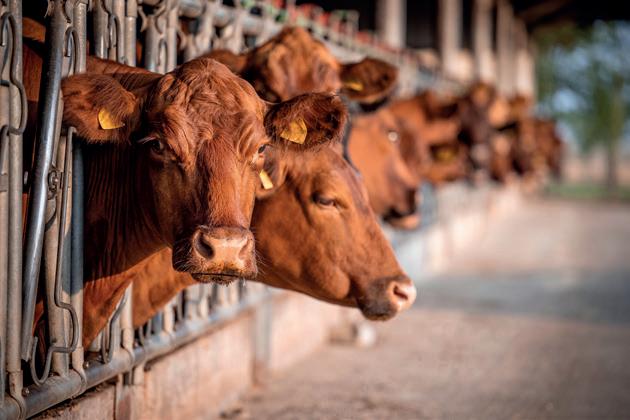

News
Rishi Sunak's pledge on food security
Arable Concern at land taken out of production
Soil health Study reveals secrets of regenerative farming
Water Tax breaks needed to encourage investment
Fen Tiger French protests get results for farmers








March 2024
Winning ways: Skyscraper delivers for wheat grower Tel: 01480 495956 www.flr-cropdrying.com









ALLEVIATES PRESSURE POINTS





UNIQUELY VERSATILE ONLY KANTOR®



“Flexibility is key when it comes to crop protection, and that’s what Kantor® gives us”
Luke Medd, Partner, N Medd and Son, County Durham

ACROSS THE ENTIRE SPRAYING OPERATION












Scan the QR code to read Luke’s story
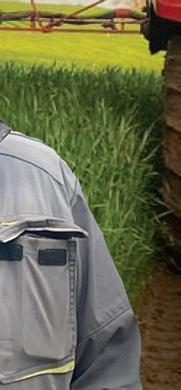
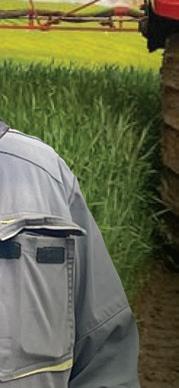



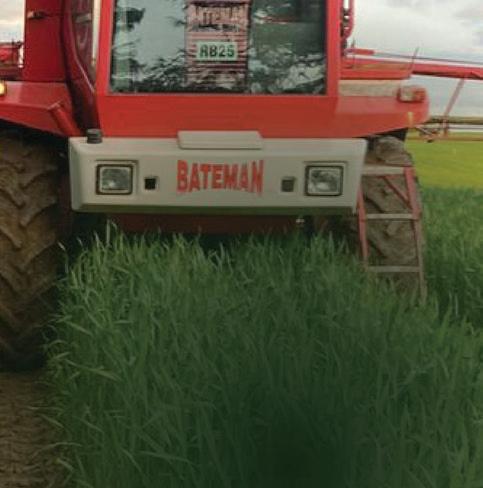
The go-to-adjuvant for tank mix recovery and complex tank-mixing in a single pass, Kantor® improves the efficiency and effectiveness of all products in your tank.



www.interagro.co.uk

Improved rainfastness and valuable drift reduction extends the spray window for chemical application, keeping you spraying in challenging weather conditions.
Enhanced coverage across plants leads to more effective and targeted control, whilst unique penetrative power helps active ingredients get to work faster, increasing the efficacy of your spray mix.


















Kantor® is a registered trademark of Interagro (UK) Ltd
ADJUVANT


Anglia Farmer
EDITORIAL
Editor:
Johann Tasker | T: 07967 634971
E: johann@ruralcity.co.uk
Design:
Mark Shreeve | T: 01502 725839
E: mark.shreeve@micropress.co.uk
Advertisement production:
Jade Soanes | T: 01502 725840
E: jade.soanes@micropress.co.uk
ADVERTISING SALES
Wes Stanton | T: 01502 725866
E: wes.stanton@micropress.co.uk
Daniel Rice | T: 01502 725858
E: daniel.rice@micropress.co.uk
Mat Roffey | T: 01502 725854
E: mat.roffey@micropress.co.uk
Mark Tait | T: 01502 725803
E: mark.tait@micropress.co.uk
OPINION Johann Tasker
Beware of politicians bearing gifts
It's not often a prime minister addresses the NFU annual conference. In fact, when Rishi Sunak addressed farmers in Birmingham last month, he was the first prime minister to do so since Gordon Brown took to the stage in 2008.

grants would help increase productivity, with more support for processing, packing and onfarm retailing.
The prime minister also announced that Defra is doubling the management payment made under the Sustainable Farming Incentive. This means farmers who join the scheme can now receive £1000 instead of £2000. That is new money and it will be welcome.





Anglia Farmer is a controlled circulation magazine published monthly for farmers and growers in the eastern counties. To be included on the circulation list, a farmer must have a minimum of 70 acres of land, or 50 dairy/beef stock, or 50 breeding sows/250 growing stock, or 15,000 laying hens/broiler chickens. Intensive horticulture units are required to have a minimum of two hectares. Subscription is £18 a year (including postage). No responsibility can be accepted by the publishers for the opinions expressed by contributors.
If you no longer wish to receive this magazine, please email your name, address and postcode as it appears on the wrapper to gemma.mathers@micropress.co.uk
© Countrywide Publications 2024
Published by Countrywide Publications, Fountain Way, Reydon Business Park, Reydon Suffolk IP18 6DH
T: 01502 725800
Printed by Micropress Ltd, Suffolk. T: 01502 725800




Mr Sunak was keen to demonstrate his farming credentials. “I’ve been to the auction marts,” he told conference delegates. “I’ve visited upland farms, hill farms, arable and livestock farms. I even tried my hand at milking once – not very successfully I must say.”
The prime minister was also keen to show how much the government supports farmers. Grants worth £427m will be opened to farmers this year, he said – including £220m for technology and productivity schemes (see page 4).
How much of this is new money remains to be seen. The government has history when it comes to making the same announcement twice – and Mr Sunak was soon talking about maintaining the farming budget for England at £2.4 billion per year.
Politicians like to tailor what they say to suit their audience. Mindful that farmers are first and foremost food producers, Mr Sunak said the
But the government could do so much more to support farming. And not necessarily when it comes to cash. Mr Sunak insists the government is taking food security seriously – and will now hold an annual food summit to discuss the issue.
That will be welcome. But Mr Sunak's fine words ring rather hollow when the trade deals announced by the government since Brexit threaten to undermine British farmers with imports of cheap food produced using methods that are illegal in the UK.
Anyone would think there's a general election on the way.
Johann Tasker Editor









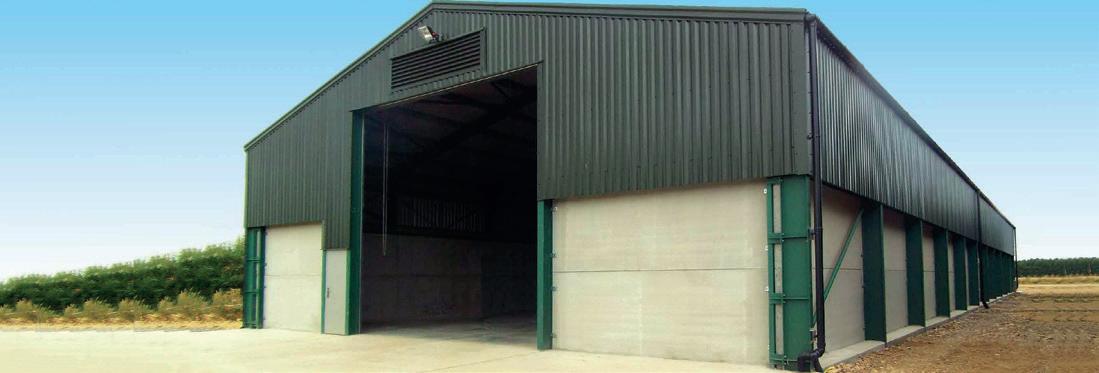


Vol 44 • No 3 • March 2024 Contents MARCH 2024 • ANGLIA FARMER 3
News .................................................................... 4 Arable .................................................................. 9 Soil health ....................................................... 25 Water .................................................................. 33 Livestock: Focus on Beef & Sheep .......... 41 Professional services .................................. 45 Fen Tiger .......................................................... 54 Visit our website for all the latest farming news
BOWIE LOCKWOOD 02476 459000 sales@bowielockwood.co.uk SHORT OF STORAGE SPACE? SHORT OF STORAGE SPACE? RIDBA Rural & Industrial Design & Building Association Competitive prices for all your agricultural & industrial requirements Competitive prices for all your agricultural & industrial requirements CONTACT US NOW! 67639
Government makes pledge on UK food security
• Prime minister in key pledge
• Annual assessment 'is critical'
• Food summit held every year
Grants worth £427m will be opened to farmers this year –following an announcement by Prime Minister Rishi Sunak at last month's NFU conference.
The package will include £220m for technology and productivity schemes, said Mr Sunak – ensuring the government delivered on its commitment to maintain the farming budget for England at £2.4 billion per year for the duration of this parliament.
The schemes would ensure farmers could access new equipment, including kit which increases automation to reduce reliance on overseas workers. It would also fund cost-saving energy measures, such as rooftop solar, to safeguard land for food production.
The multi-million-pound funding pot will also increase support for processing, packing and retailing on

farms. It doubles investment in productivity schemes, growing the grant offer from £91m to keep up with demand from farmers.
Farm support
Almost half of farmers in England were now receiving government support through new schemes created post-Brexit, said Mr Sunak. “We’ll never take our food security for granted. We’ve got a plan to support British farming – and we’re going further again today.”
The Prime Minister also confirmed plans to reduce red tape around permitted development rights – encouraging farmers to develop buildings and diversify earnings through farm shops, commercial space and sporting venues.
It is expected to benefit the broader rural community by increasing job
'Cynical' giveaway won’t win back farmers – Lib Dems
Responding to the Rishi Sunak's £220m funding package, Liberal Democrat leader Ed Davey accused the prime minister of selling farmers short.
“Conservative prime ministers have spent years taking farmers for granted,” he said. “From the botched rollout of farm payments to trade deals undercutting our farmers, this government has let down rural communities at every turn.”
Rural communities had been ignored by Mr Sunak, said Mr Davey. “His government just doesn’t care and doesn’t get it, this cynical pre-election giveaway doesn't do anything
to change that.”
“We’ll never take food security for granted
opportunities and commercial units available, helping local residents to develop small and medium enterprises in rural communities, and connecting communities more with their local farms.
Mr Sunak also announced a new annual Food Security Index to monitor levels of UK food security. He pledged to hold an annual Farm to Fork Summit – similar to the Downing Street event last year – and unveiled a £15m fund to help reduce food waste from the farm gate.
NFU campaign
It follows a sustained NFU campaign on food security. Former NFU president Minette Batters said: “I think it’s significant. When we left the EU we were told the Agriculture Bill would be five-yearly reporting. It was a real battle to get it to every three years.”
She added: “The good thing about annual reporting focusing on the UK is it means we will be measuring more often, allowing us to monitor the situation, and can see if we have a problem and do something about it.”
The Lib Dems claim that Defra's own figures show a £227m shortfall in government spending on agriculture. And they say the government’s seasonal worker scheme has allowed farmers to recruit just 45,000 employees from overseas, when the NFU says 70,000 workers are needed.
The Lib Dems also say the government voted against measures for an impact assessment on the effect the Australia and New Zealand trade deals would have on farmers – despite arguments that there had been insufficient parliamentary oversight.
With a general election expected this year, Ms Batters said she hoped all political parties would commit to hosting an annual domestic food security summit. The issue was vital to the wider general public – not just the farming sector, she suggested.
“Annual assessments will be critical to all of this. Commitment to core standards will also be key. We have to implement core standards that will mean our negotiators will have a clear mandate on which to negotiate these trade deals. That has to happen.”
4 ANGLIA FARMER • MARCH 2024 News
Floods caused by winter storms are much worse than in 2019


UnivoqTM

PROTECTION
a higher yield and a profitable harvest
novel site of action with no cross resistance to any other chemistry
spectrum and rainfast, UnivoqTM gets to work quickly
ULTIMATE
For
UNIQUE A
FLEXIBLE Broad
ROBUST
long-lasting disease control Protect now. Profit later.
Exceptional crop coverage providing
profit
more
benefits
our
Unique, flexible cereal disease control. Discover more at www.corteva.co.uk Technical Hotline: 0800 689 8899 E-mail: ukhotline@corteva.com USE PLANT PROTECTION PRODUCTS SAFELY. Always read the label and product information before use. For further information including warning phrases and symbols refer to label. Corteva Agriscience UK Limited, CPC2 Capital Park, Fulbourn, Cambridge CB21 5XE. Tel: 01462 457272. ®, ™ Trademarks of Corteva Agriscience and its affiliated companies. © 2024 Corteva. Univoq™ contains fenpicoxamid (Inatreq™ active) and prothioconazole.
fungicide offers persistent protection and curative control of all Septoria strains. Its broad-spectrum disease control ensures a higher yield, to secure your
and protect the future of your farm. Discover
about the
of Univoq and
latest application advice at: www.corteva.co.uk/univoq
Regenerative farming in spotlight at Writtle
Farmers joined leading academics to discuss regenerative agriculture and food production at the Writtle Farmers’ Club’s annual conference last month.
Held at Writtle University College, near Chelmsford, speakers included National Trust tenant Andy Cato, co-founder of the Wildfarmed conservation agriculture brand, which rewards farmers who use more sustainable methods of growing cereal crops.
He said: “In my years as a farmer, gaining first-hand experience of what an incredibly difficult and often very lonely profession it is, a key lesson was that knowledge exchange and collab-
oration are fundamental if we are to move towards systemic change.
“For a long time, I’ve been immersed in the practical difficulties of farming that combines food and nature, and field to plate supply chains that can support it. So it’s fantastic to see that the dial is moving and Writtle are leading the way, both teaching and bringing together people.”
Groundswell
Mr Cato was joined at the conference by no-till farming experts John and Joanna Cherry, hosts of the two-day annual Groundswell event in Hertfordshire. Other speakers included dairy and beef producer Becky Mayhew, who farms 200ha in south Norfolk.

March
6-7 Low Carbon Agriculture 2024, Stoneleigh (above) www. lowcarbonagricultureshow.co.uk
12 Andersons Prospects for Agriculture 2024, Newmarket www.theandersonscentre.co.uk
14 Andersons Prospects for Agriculture 2024, Newark www.theandersonscentre.co.uk
April
27-28 East Anglian Game & Country Fair
May
12 South Suffolk Show, Ingham, Bury St Edmunds
15-16 Pig & Poultry Fair
18 Hadleigh Show, Hadleigh, Suffolk
19 Essex Young Farmers’ Country Show, Roxwell, Chelmsford
26-27 Hertfordshire County Show, Redbourn
29-30 Suffolk Show, Ipswich
To list your event for free, please email editor@ruralcity.co.uk
Academics included Tim Land, emeritus professor of food policy at City University London's Centre for Food Policy in 2021. He was joined by Professor Peter Hobson from the School of Sustainable Environments at Writtle University College.
The conference was organised by farmer and regenerative agriculture lecturer William Hudson. He said: “The Writtle Farmers’ Club is for all those who care about the environment and are involved in the production of
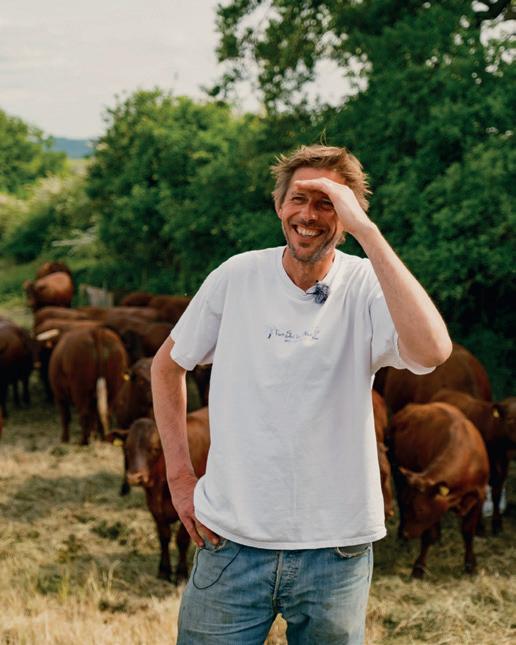
Speakers included Wildfarmed co-founder Andy Cato
healthy, sustainable food.”
Writtle University College (WUC) is on the edge of Writtle village, in the middle of the Essex countryside.
Established in 1893, Writtle is one of the UK's oldest specialist institutions. It completed a formal merger with Anglia Ruskin University last month to become ARU Writtle, and will continue to offer courses in agriculture and land-based sciences.
Beware of horses on rural roads
Tractor drivers and motorists are being urged to take care after statistics showing that five in cidents involving horses are recorded on roads every week in the east of England.
Across the region, a total of 282 horse-related inci dents were recorded with the British Horse Society in 2023. Suffolk experienced the most incidents at 62, up by 24% compared to 2022. Comparatively, Hertford shire had 54 incidents and Essex had 49.
These figures are a stark reminder that road incidents involving equestrians continue to persist, said the socie ty. This is despite the changes implemented in the High way Code in 2022, which set out clear guidance for pass ing equestrians safely.
BHS safety director Alan Hiscox said: “It is clear that a significant number of drivers are still unaware of the advice in the Highway Code and the importance of driv ing carefully when passing and approaching horses.”
The BHS is also offering clear advice for equestrians to follow when out on the roads with their horse – includ ing wearing hi-vis and reflective equipment as well as using the appropriate hand signals to make other road users aware of their intentions.

Motorists should pass horses slowly
6 ANGLIA FARMER • MARCH 2024 News












































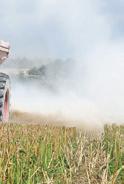




























































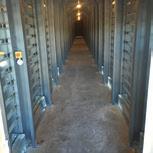



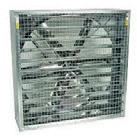



Customer service 0800 090 2376 LimeX is a business of British Sugar The UK’s No.1 Liming Product P2O5 - 9kg/t MgO - 8kg/t SO3 - 7kg/t www.limex.co.uk Save £££’s on fertiliser this year with LimeX Scan for quote MARCH 2024 • ANGLIA FARMER 7 Call 01236 421835 e: info@drivers-seats.com www.drivers-seats.com Forklift seats and seat spares for all types. Full stock of GRAMMER seats and spare parts in stock. KAB SCIOX tractor seats. Full range of economy tractor seats. Truck seats from GRAMMER, KAB and ISRI. Seat repairs, covers and spare parts for all ranges. Thomas Scott Seating Celebrating 96 years in business 1924-2020 PELLCROFT www.pellcroft.com sales@pellcroft.com 01526 342466 Manufacturers of centrifugal, low volume and portable fans, air tunnels, drive over floors, grain stirrers and gas burners.
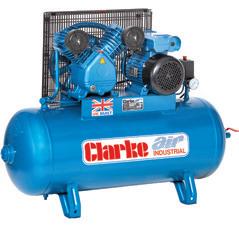




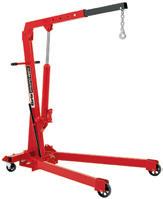
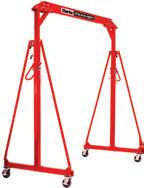
























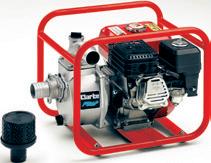



























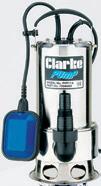


20SPS12 UP TO 7938KG CAPACITY IN STOCK Model Capacity exc.VAT inc.VAT 20SPS12 907kg £89.98 £107.98 25SPS12 1134kg £124.99 £149.99 FROM ONLY DOUBLE DOUBLE FOOTER 89.98 £107.98 inc.VAT exc.VAT X-LARGE, HEAVY DUTY GARAGES/WORKSHOPS GENERATORS INVERTER GENERATORS TURBO AIR COMPRESSORS DRILL PRESSES WORKSHOP CRANES 5 TONNE FORKLIFT/TRACTOR JACK - CFT5B JUMP STARTS HEAVY DUTY SUBMERSIBLE WATER PUMPS INDUSTRIAL AIR COMPRESSORS Top quality belt driven air compressors for industrial & commercial users inc; garages, factories, workshops and farms. 10 bar/145psi max working pressure V-Twin 230V FROMHEADERONLY MODEL DISP CFM MOTOR (HP) AIR RCVR EXC.VAT INC.VAT XEV16/100 (OL)†* 14 3 100ltr £589.00 £706.80 XEV16/150 (OL)†* 14 3 150ltr £659.00 £790.80 XEV16/200(OL)†* 14 3 200ltr £719.00 £862.80 XEV16/150(400V)† 14 3 150ltr £699.00 £838.80 XE29/270 (OL) 28 6 270ltr £1399.00 £1678.80 SE46C270 (400V) 40 10 270ltr £2129.00 £2554.80 XE37/270 (OL)* 36 2x 4 270ltr £1479.00 £1774.80 HIGH LIFTS UPTO 730mm LOW LIFTS FROM 70mm HUGE RANGE OF JACKS IN STOCK Provides essential home, garage and roadside assistance Integral work light 910 /JS1100C include air compressor Long life battery EXTRA LONG 1m LEADS Model Starting Boost Peak Amps exc.VAT inc.VAT 910 400 900 £96.99 £116.39 JS1100C 500 1100 £96.99 £116.39 4000 1100 2200 £164.99 £197.99 JS12/24 1000 2000 £179.98 £215.98 FROM ONLY DOUBLE DOUBLE FOOTER £96.99 £116.39 inc.VAT exc.VAT *Pumps solids up to 35mm dia. #Clean/ dirty water (solids up to 5mm dia.) †Sewage cutter pump HSEC650A PVP11A Model Max Flow LPM Max Head exc.VAT inc.VAT PVP11A* 258 11.0m £89.98 £107.98 HSE130A# 140 7.0m £119.98 £143.98 HSEC650A 290 9.5m £249.00 £298.80 HSE1400A† 430 13m £389.00 £466.80 FROM ONLY DOUBLE DOUBLE FOOTER £89.98 £107.98 inc.VAT exc.VAT Range of precision bench & floor presses for enthusiast, engineering & industrial applications B = Bench mounted F = Floor standing model Motor (W) Speeds exc.VAT WAS inc.VAT inc.VAT CDP5EB 350 / 5 £99.95 £119.94 CDP102B 350 / 5 £115.95 £139.14 CDP152B 450 / 12 £209.00 £251.98 £250.80 CDP202B 450 / 16 £269.00 £322.80 CDP352F 550 / 16 £339.00 £406.80 CDP452B 550 / 16 £299.00 £406.80 £358.80 CDP502F 1100 / 12 £699.00 £934.80 £838.80 FROM ONLY DOUBLE DOUBLE FOOTER £99.95 £119.94 inc.VAT exc.VAT Superb range ideal for DIY, hobby & semiprofessional use TIGER 16/1050 Model Motor CFM Tank exc.VAT inc.VAT 8/260 2HP 7 24ltr £119.98 £143.98 11/550 2.5HP 9.3 50ltr £179.98 £215.98 16/550 3HP 14.5 50ltr £249.00 £298.80 16/1050 3HP 14.5 100ltr £309.00 £370.80 Honda engine models available 12V battery charging facility model Max Output Weight KG exc.VAT inc.VAT IG950D 800W 9.3 £219.00 £262.80 IG1200D 1100W 12.4 £279.00 £334.80 IG1700F 1700W 22 £259.00 £310.80 IG2000D 1800W 19.4 £399.00 £478.80 IG3500AF* 3400W 35 £379.00 £454.80 IG2200A 2200W 26.6 £429.00 £514.80 IG2200A FROM ONLY DOUBLE DOUBLE FOOTER £219.00 £262.80 inc.VAT exc.VAT Model Volts HP exc. VAT WAS inc.VAT inc. VAT PG2500A 230 5.6 £219.00 £270.00 £262.80 PG3800A 230 5.6 £269.00 £346.80 £322.80 PG3800ADV 230/110 5.6 £299.00 £370.80 £358.80 PG6500ADVES 230/110 9.7 £539.00 £658.80 £646.80 DIESEL GENERATORS UP TO 125kVA ALSO IDEAL FOR RAIN & SUN PROTECTION SMALLER SIZES FROM £298.80 Model size (LxWxH) exc.VAT inc.VAT CIG1432 9.7x4.3x3.65m £1099.00 £1318.80 CIG1640# 12x4.9x4.3m £2599.00 £3118.80 14.5' HIGH CIG1640 Model Desc. exc.VAT inc.VAT CFC100# 1 Tonne Folding Workshop Crane £219.98 £263.98 CWGC1000‡ Gantry Crane 1T £529.00 £634.80 CFC100 SCREW COMPRESSORS UPTO 371 CFM XEV16/100 PRICE CUT DOUBLE DOUBLE WAS £298.80 inc.VAT £239.00 £286.80 inc.VAT exc.VAT FROM ONLY DOUBLE DOUBLE FOOTER £119.98 £143.98 inc.VAT exc.VAT FROM ONLY DOUBLEDOUBLEFOOTER £219.98 £263.98 inc.VAT exc.VAT PRICE CUT DOUBLE DOUBLE WAS £682.80 inc.VAT £529.00 £634.80 inc.VAT exc.VAT ONLY DOUBLE DOUBLE FOOTER £1099.00 £1318.80 inc.VAT exc.VAT CIG1432 12' HIGH 32' LONG BRIGHT WHITE INTERIOR inc.VAT SAVE UP TO £360 40'LONG MIG WELDERS Quality machines from Britain’s leading supplier See online for included accessories 135TE HEADER exc.VAT FROM ONLY £298.80 inc.VAT £249.00 Model Min/Max Amps exc.VAT inc.VAT PRO90 25-90 £249.00 £298.80 135TE Turbo* 30-130 £289.98 £347.98 151TE Turbo 30-150 £345.00 £414.00 160TM 30-150 £359.00 £430.80 * WAS £356.39 inc.VAT PETROL ENGINE WATER PUMPS Delivery & Suction hose in stock PW50A *Can pump solids up to 15mm dia. #Can pump solids up to 28mm dia. Model Type Max Flow Outlet Size exc. VAT inc.VAT PW50A Standard 550L/min 2" £189.98 £227.98 PW80A Standard 1100L/min 3" £199.98 £239.98 PS75A* Semi-trash 750L/min 3" £279.00 £334.80 PF75A# Full-trash 1300L/min 3" £379.00 £454.80 HEADER exc.VAT FROM ONLY £227.98 inc.VAT £189.98 * WAS £358.80 inc.VAT # WAS £478.80 inc.VAT * WAS £466.80 inc.VAT PETROL & DIESEL PRESSURE WASHERS PLS265B Honda & Diesel engine models in stock Model Pressure BAR/Psi Engine HP exc.VAT inc.VAT Tiger1800B 110/1595 3 £279.00 £334.80 Tiger2600B 180/2610 4 £379.00 £454.80 Tiger3000B 200/2900 6.5 £399.00 £478.80 PLS195B 180/2640 5.5 £499.00 £598.80 PLS220 230/3335 9 £679.00 £814.80 PLS265B 225/3263 13 £769.00 £922.80 PLS360 248/3600 13 £998.00 £1197.60 DLS200AL* 200/2900 8.5 £2399.00 £2878.80 Diesel CAN DRAW OWN WATER HEADER exc.VAT FROM ONLY £334.80 inc.VAT £279.00 PG3800ADV FAN HEATERS FROM ONLY DOUBLE DOUBLE FOOTER £29.98 £35.98 inc.VAT EXC.VAT Model Max. Output exc.VAT inc.VAT DEVIL 2000PTC-B 2kW £29.98 £35.98 Devil 2850 2.8kW £42.99 £51.59 Devil 2800PTC-B 2.8kW £49.98 £59.98 TURBO FAN GAS HEATERS ELECTRIC HEATERS DIESEL/PARAFFIN HEATERS Offering low cost, efficient heating DUAL VOLTAGE 230& 110 VOLT IN STOCK FROM inc.VAT Model Max. Output kW exc.VAT inc.VAT Little Devil II 10.3 £94.99 £113.99 Devil 700 15 £119.98 £143.98 Devil 900 24.9 £159.98 £191.98 Devil 1600 36.6 £189.98 £227.98 Devil 2100 49.8 £269.00 £322.80 Devil 4000 131 £479.00 £574.80 Propane gas fired FROM ONLY DOUBLE DOUBLE FOOTER £94.99 £113.99 inc.VAT exc.VAT XR80 2800PTC-B 2850 Ideal for fast efficient heating Extra-long run fuel tanks – up to 53 litres Variable heat output with thermostat control model MAX output exc.VAT inc.VAT XR60 14.7kW £229.00 £274.80 XR80 20.5kW £279.00 £334.80 XR110 29.3kW £329.00 £394.80 XR160 46.9kW £399.00 £478.80 XR210 61.5kW £459.00 £550.80 FROM ONLY DOUBLE DOUBLE FOOTER £229.00 £274.80 inc.VAT exc.VAT 2.8kW 2.8kW Model Voltage Heat Output exc.VAT inc.VAT Devil 6003 230V 1.5-3kW £69.98 £83.98 Devil 7003* 230V 3kW £76.99 £92.39 Devil 7005# 400V 5kW £98.99 £118.79 Devil 6009 400V 4.5-9kW £124.99 £149.99 Devil 7009 400V 9kW £152.99 £183.59 Devil 6015 400V 5-10-15kW £189.98 £227.98 Devil 7015 400V 15kW £229.98 £275.98 DEVIL 6003 FROM ONLY DOUBLE DOUBLE FOOTER £69.98 £83.98 inc.VAT EXC.VAT DEVIL 7003 BEST SELLER NEW BARNSLEY Pontefract Rd, Barnsley, S71 1EZ 01226 732297 B’HAM GREAT BARR 4 Birmingham Rd. 0121 358 7977 B’HAM HAY MILLS 1152 Coventry Rd, Hay Mills 0121 7713433 BOLTON 1 Thynne St. BL3 6BD 01204 365799 BRADFORD 105-107 Manningham Lane. BD1 3BN 01274 390962 BRIGHTON 123 Lewes Rd, BN2 3QB 01273 915999 BRISTOL 1-3 Church Rd, Lawrence Hill. BS5 9JJ 0117 935 1060 BURTON UPON TRENT 12a Lichfield St. DE14 3QZ 01283 564 708 CAMBRIDGE 181-183 Histon Road, Cambridge. CB4 3HL 01223 322675 CARDIFF 44-46 City Rd. CF24 3DN 029 2046 5424 CARLISLE 85 London Rd. CA1 2LG 01228 591666 CHELTENHAM 84 Fairview Road. GL52 2EH 01242 514 402 CHESTER 43-45 St. James Street. CH1 3EY 01244 311258 COLCHESTER 4 North Station Rd. CO1 1RE 01206 762831 COVENTRY Bishop St. CV1 1HT 024 7622 4227 CROYDON 423-427 Brighton Rd, Sth Croydon 020 8763 0640 DARLINGTON 214 Northgate. DL1 1RB 01325 380 841 DEAL (KENT) 182-186 High St. CT14 6BQ 01304 373 434 DERBY Derwent St. DE1 2ED 01332 290 931 DONCASTER Wheatley Hall Road 01302 245 999 DUNDEE 24-26 Trades Lane. DD1 3ET 01382 225 140 EDINBURGH 163-171 Piersfield Terrace 0131 659 5919 EXETER 16 Trusham Rd. EX2 8QG 01392 256 744 GATESHEAD 50 Lobley Hill Rd. NE8 4YJ 0191 493 2520 GLASGOW 280 Gt Western Rd. G4 9EJ 0141 332 9231 GLOUCESTER 221A Barton St. GL1 4HY 01452 417 948 GRIMSBY ELLIS WAY, DN32 9BD 01472 354435 HULL 8-10 Holderness Rd. HU9 1EG 01482 223161 ILFORD 746-748 Eastern Ave. IG2 7HU 0208 518 4286 IPSWICH Unit 1 Ipswich Trade Centre, Commercial Road 01473 221253 LEEDS 227-229 Kirkstall Rd. LS4 2AS 0113 231 0400 LEICESTER 69 Melton Rd. LE4 6PN 0116 261 0688 LINCOLN Unit 5. The Pelham Centre. LN5 8HG 01522 543 036 LIVERPOOL 80-88 London Rd. L3 5NF 0151 709 4484 LONDON CATFORD 289/291 Southend Lane SE6 3RS 0208 695 5684 LONDON 6 Kendal Parade, Edmonton N18 020 8803 0861 LONDON 503-507 Lea Bridge Rd. Leyton, E10 020 8558 8284 LUTON Unit 1, 326 Dunstable Rd, Luton LU4 8JS 01582 728 063 MAIDSTONE 57 Upper Stone St. ME15 6HE 01622 769 572 MANCHESTER ALTRINCHAM 71 Manchester Rd. Altrincham 0161 9412 666 MANCHESTER CENTRAL 209 Bury New Road M8 8DU 0161 241 1851 MANCHESTER OPENSHAW Unit 5, Tower Mill, Ashton Old Rd 0161 223 8376 MANSFIELD 169 Chesterfield Rd. South 01623 622160 MIDDLESBROUGH Mandale Triangle, Thornaby 01642 677881 NORWICH 282a Heigham St. NR2 4LZ 01603 766402 NORTHAMPTON Beckett Retail Park, St James’ Mill Rd 01604 267840 NOTTINGHAM 211 Lower Parliament St. 0115 956 1811 PETERBOROUGH 417 Lincoln Rd. Millfield 01733 311770 PLYMOUTH 58-64 Embankment Rd. PL4 9HY 01752 254050 POOLE 137-139 Bournemouth Rd. Parkstone 01202 717913 PORTSMOUTH 277-283 Copnor Rd. Copnor 023 9265 4777 PRESTON 53 Blackpool Rd. PR2 6BU 01772 703263 SHEFFIELD 453 London Rd. Heeley. S2 4HJ 0114 258 0831 SIDCUP 13 Blackfen Parade, Blackfen Rd 0208 3042069 SOUTHAMPTON 516-518 Portswood Rd. 023 8055 7788 SOUTHEND 1139-1141 London Rd. Leigh on Sea 01702 483 742 STOKE-ON-TRENT 382-396 Waterloo Rd. Hanley 01782 287321 SUNDERLAND 13-15 Ryhope Rd. Grangetown 0191 510 8773 SWANSEA 7 Samlet Rd. Llansamlet. SA7 9AG 01792 792969 SWINDON 21 Victoria Rd. SN1 3AW 01793 491717 TWICKENHAM 83-85 Heath Rd.TW1 4AW 020 8892 9117 WARRINGTON Unit 3, Hawley’s Trade Pk. 01925 630 937 WIGAN 2 Harrison Street, WN5 9AU 01942 323 785 WOLVERHAMPTON Parkfield Rd. Bilston 01902 494186 WORCESTER 48a Upper Tything. WR1 1JZ 01905 723451 VISIT YOUR LOCAL SUPERSTORE Open Mon-Fri 8.30-6.00, Sat 8.30-5.30, Sun 10.00-4.00 Calls to the catalogue request number above (0844 880 1265) cost 7p per minute plus your telephone company’s network access charge. For security reasons, calls may be monitored. All prices correct at time of going to press. We reserve the right to change products and prices at any time. Check online for latest prices. All offers subject to availability, E&OE. *Terms & conditions apply see machinemart.co.uk/finance for more details NEW 492 PAGE CATALOGUE GET YOUR FREE COPY! • IN-STORE • ONLINE • PHONE 0844 880 1265 34357 65 SUPERSTORES NATIONWIDE Britain’s Tools & Machinery Specialist 5 EASY WAYS TO BUY... SUPERSTORES SUPERSTORES NATIONWIDE ONLINE www.machinemart.co.uk TELESALES 0115 956 5555 CLICK & COLLECT OVER 10,500 LOCATIONS CALL & COLLECT AT STORES TODAY
'Unforeseen consequences' as land is taken out of food production
• Concern over impact on production
• More farmers opting into scheme
• Defra could put limit on applications
Large amounts of land are being taken out of food production and put into the government's flagship agri-environment scheme, the Sustainable Farming Incentive, say agronomists.
Contractors and farmers could struggle to survive where large areas of arable land are being put into the scheme, which is being seen by some growers as less risky than producing food crops.
The Association of Independent Crop Consultants issued the warning after being briefed by Defra representatives at their annual technical conference earlier this year. It came as the government unveiled its 2024 scheme offer.
An interactive poll at the conference found that the vast majority of AICC members are actively involved in SFI applications – either taking control of the process or advising clients on the most suitable actions for their farms.
Impartial advice provided by AICC members is seen as particularly im-
portant in the implementation of integrated pest management (IPM) options within the SFI, along with soil and nutrient management plans.
Attendees at the conference reported significant areas of arable land being taken out of food production and put into non-food producing SFI options, with Defra increasing the payment rates increased for farmers opting into the scheme this year.
Whilst there is an acceptance farmers need to be incentivised to produce food more sustainably, there is a fear it could have devastating consequences for associated agri-businesses, including agronomy services.
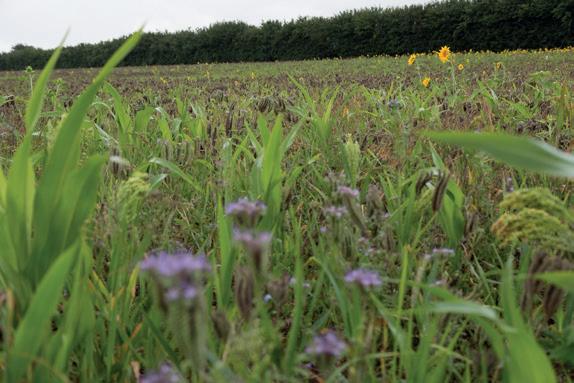
AICC chairman Andrew Blazey said agronomists were having to adapt to rapid changes playing out in UK agriculture. “This is in addition to risk management and ensuring the crop production side of the business performs to its full potential.”


'Critical issues'
TBuckinghamshire based agronomist Andrew Cotton said contractors and farmers reliant on contracting their neighbours' farms could struggle to survive, especially where large areas of arable land were being put into SFI, which is increasingly common.
Land is being put into environmental schemes rather than farmed Agronomists are adapting rapidly to new policies, says Andrew Blazey (below)
grain trailer manufacturer, who has seen sales plummet.”
Defra’s Fiona James said the government would act promptly to address any critical issues. The government was keeping a watching brief for any unintended consequences arising from the SFI – whether they were environmental or economic.







Once these businesses are lost, it would be very difficult for them to re-enter the industry due to the ever-increasing cost of new machinery, he said. “It has already had a significant impact on a local










Defra had indentified similar concerns, acknowledged Ms James. “It’s how we build up over time from anecdotal evidence to hard facts that [will] enable us to have the evidence base... to course correct, to iterate our measures over time.”








SFI payment rates for 2024 are 10% higher than previously with farmers able to choose from 50 new actions. Stacking these options as part of a three-year SFI agreement is encouraged and Defra hopes 70% of farms will be in the scheme by 2028.


Rothamsted 'fully focused' on scientific research
he Rothamsted Reseach centre says it remains fully focused on its scientific programmes amid what it acknowledges is a challenging financial situation.
It follows a report by The Guardian that the research facility has warned staff they will have to pause “non-essential” work –announcing a hiring pause and warning of pay freezes due to what the newspaper described as a funding crisis.
In a statement, Rothamsted said: “We are fully focused on our scientific pro-
gramme, generating impactful outcomes from our many research commitments, and remain very much 'open for business' for all our partners and collaborators.
Peer reviewed
“Our science is in a great place, having been exhaustively peer reviewed for the next five years of BBSRC funding. As an institute we are addressing fundamental issues of food security and valuing environmental services for a sustainable net zero future at national
and global scales.
“As the longest serving and most renowned UK agricultural research facility we feel privileged to be part of such vital work. We are an independent institute supported to deliver our strategic science programmes by the BBSRC. We acknowledge the financial situation as challenging, as it is for many similar institutes and universities, and are working hard to implement necessary change as would be expected from any effective management team.”
MARCH 2024 • ANGLIA FARMER 9
Arable
do’s and don’ts for winter wheat disease control 5
Keeping winter wheat crops clean and healthy will be a challenge this spring, says
Mike Thornton
.
Wide variations in drilling dates, the wet winter and the early appearance of disease mean winter wheat crops will need managing on a fieldby-field basis this season.
The best growers will be paying close attention to every crop – not just those that are struggling. Just as much effort, if not more, will be needed to protect backward crops as normal ones to ensure further yield potential isn’t eroded.
Here are five tips to get on top of disease control:
1 Do remember the importance of early disease management
While it might be tempting to ease back on early fungicide inputs if crop potential has been compromised by delayed drilling or poor winter growth, diseases are already present. A T0 fungicide provides a wider management tool.
Yellow rust is already being found in crops, particularly in the southern half of the country, and it becomes more difficult to control later. Similarly, Septoria is easy to find in early-drilled crops.
As well as targeting diseases present at

application, a T0 fungicide provides a level of insurance in case the follow-up T1 fungicide is delayed. We saw this in 2023; in fields where T0 fungicides were omitted, Septoria exploded once the rains arrived in March.
2 Don’t get caught out with spray timings
Accurately timing fungicide sprays to target the correct leaf layer that has emerged is essential for maximum yield protection.
But with drilling dates varying widely from September to February this season, and varieties having different speeds of development, crop growth stages will be all over the place.
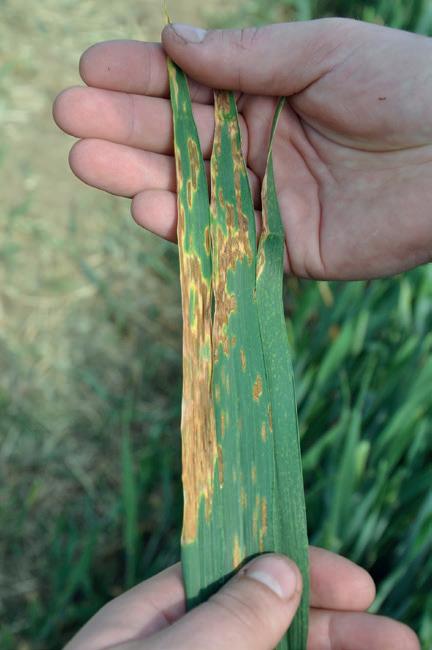
One field might reach the correct growth stage for its T1 spray early – but others may be much later. Fields will need checking individually – splitting stems to expose the developing leaves and counting back from the ear to identify which leaf layers have emerged.
3 Do pay attention to crop stress
Backward and poorly-rooted plants, whether from later drilling or because they have sat in cold, waterlogged fields over winter, together with leaching of soil nutrients by the heavy winter rainfall, mean crops are likely to be under increased stress this spring.
This makes them more vulnerable to infection, particularly yellow rust. Use accurate soil testing to identify which nutrients need topping up. But don’t just test for the nutrient levels present in the soil. Use testing which shows the levels actually available to the plant.
Consider a phosphite-based treatment such as Incite to encourage rooting.
4 Don’t discount diseases not seen for a while
Just because a disease has not been a problem for a few years, do not assume it has gone away. The root-rotting effects of takeall could be exacerbated this year if second wheat has small roots because it has sat in wet soil. If we have a dry spring and summer, take-all effects are worsened.
With more crop debris left on field surfaces due to minimum tillage, eyespot can also be a hidden threat, which increases lodging risk. Several varieties chosen for their good Septoria tritici resistance have low eyespot ratings. Make sure you know what your varieties are susceptible to.
5 Do keep your eye on the ball
Even varieties with good Septoria resistance, when drilled early, are at risk from the disease – so don’t let variety resistance ratings make you complacent.
Similarly, last year’s hot, dry June brought sudden yellow rust outbreaks in some areas, he says, illustrating how disease pressures can suddenly change.
The lesson is to ensure you have all likely disease threats covered. As a national company, we’re able to monitor disease development around the country. Having persistent protection from the fungicide is also important.
Mike Thornton is head of crop production for agronomy company ProCam.
Arable
Septoria can easily be found in earlierdrilled crops








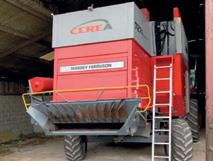


FOR ALL DRAINAGE AND SEWAGE TREATMENT PLANT NEEDS

Tractors & Telehandlers
• MF 240 - p/steering
• MF 6480 - Dyna 4, v tidy
• MF 3060 - 4 autotronic, v tidy
• MF 6120 - v tidy, Dyna shift, 4,700hrs
• New Holland TD80 & loader, 5,900hrs
• Caterpillar 407 ag telehandler (2009) - tidy
• Various forks & grapples
Harvesting
• MF 7278 AL combine (2006)24ʼ PF, v tidy
• MF 7274 combine (2004) - 22ʼ table, 208hrs
• MF 30 - 14ʼ FF - v tidy
• MF 40 RS - 20ʼ PF - v tidy
• Vicon RV2160 Round Baler, v tidy
• Krone 1290 HDP Baler, tidy
• New Holland 980 Big Bale
• Claas Liner 3100 twin rotor rake 10m
• Kv Taarup 4232 3.2 trailed mower
• New Holland 377 Baler





Other Equipment
Sewage Treatment Plant and Servicing

• Dowdeswell DP7F, 7f, v tidy
• KV LD85 5f & 4f
• Flat Lift Force - 2 leg HD buster
• Knight Raven, 3 leg combination, vgo
• Vicon PO-EDW weightcell, vgo
• Vicon RO-EDW extension hopper
• Kuhn Axis 30.1 spreader extension hopper
• Cousins 6.2m hyd rolls
• Richard Western 12t dump trailer
• Armstrong & Holmes 14.5t trailer, v tidy
• Bomford 9ʼ topper
• Major 1,600g vacuum tanker
• 80” mounted rotovator
• 450 & 600 workshop heaters
• A full range of Nugent trailers
Excavators
• Yanmar 8t & 3 buckets
• Case CX5, 5t & 3 buckets




Ditching, Hedging, Flailing



MARCH 2024 • ANGLIA FARMER 11 ELMS FARM, WELLS CORNER, LAXFIELD, SUFFOLK IP13 8EG 01986 798888 mail@lescottoncontractors.co.uk
property
sewage network? Do
tank? If so, we can install a new sewage treatment plant and provide a maintenance service. As well as servicing existing treatment plants.
Is your
off the main
you have a septic
Trimble RTK GPS
Land drainage Supporting the NHS in East Anglia
Nicest selection of MF Combines within the UK
NH TD80-4 C/W LOADER 5,980HRS MF 6120, V TIDY, DYNA SHIFT, 4,700HRS
MF 7278 AL (06) 24’ PF, V TIDY MF 7274 COMBINE, APPROX 2,000HRS
YANMAR 8 TON DIGGER C/W DITCH CLEANING BUCKET
NUGENT TIPPING TRAILER
CATERPILLAR TH336C TELEHANDLER
CASE CX50 DIGGER
Next generation sugar beet 'one step closer'
The next generation of sugar beet tolerant to Virus Yellows disease could be commercially available in 2026 – helping to end reliance on neonicotinoid seed treatments.
Breeding companies across Europe and the UK are making good progress in the development of beet varieties tolerant to all three yellowing viruses, according to latest virus-inoculated field trials by the British Beet Research Organisation.
These varieties are expected to offer similar yields to conventional varieties but without the need for seed treatments to protect from the aphid vectors of VY. That said, foliar aphicides or other IPM interventions may still be needed to protect particularly susceptible crops.
Meanwhile, Defra has granted emergency permission for growers to use neonicotinoid treatments where needed to protect 2024 crops from Virus Yellows disease, while work con-
tinues on finding a long-term solution to the problem.
The seed treatment will only be used if a predetermined, independent threshold is met this month. This threshold will be met if a Rothamsted Research model predicts a 65% Virus Yellows infection across the national sugar beet crop, compared to a 63% threshold in 2023.
Strict controls
Any use of the seed treatment is subject to strict controls. These controls include restrictions on flowering crops being planted in the same field following seed-treated sugar beet. Growers must take part in knowledge exchange programmes.
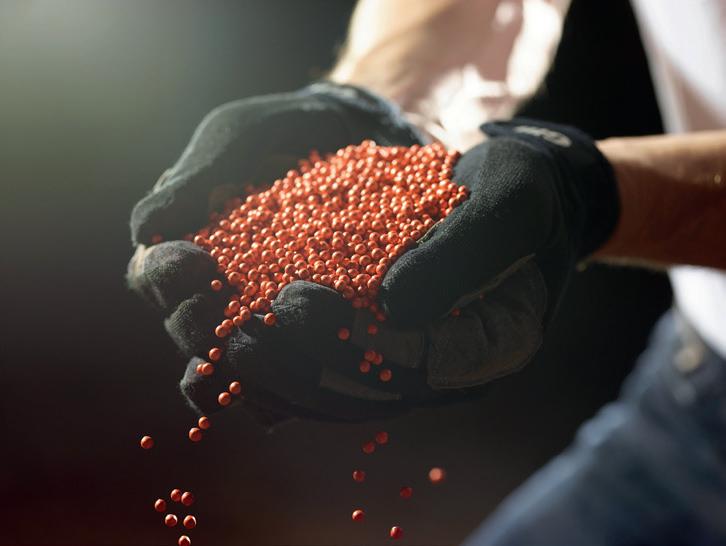
Neonicotinoid seed treatments will be allowed on beet this season
Growers must also follow a strict stewardship programme to ensure best practice and that the conditions of the emergency authorisation are met on farm. In addition, the industry has jointly funded residue monitoring over the past couple of years.
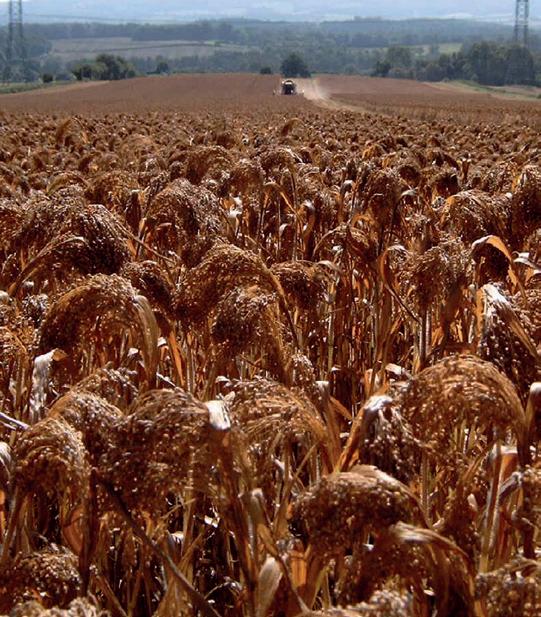
Many





British Sugar said it was continuing to work with plant breeders to improve natural resistance in the crop, innovation in on-farm techniques and grower practices, and research into how the industry can benefit from gene editing.
It added: “We look forward to understanding more about how we can use the results of this work for the benefit of our industry.”

12 ANGLIA FARMER • MARCH 2024 Arable
sales@plugandcool.co.uk | +44 (0)1621 868 138 www.plugandcool.co.uk SCAN ME! YEAR WARRANTY 5 MANUFACT RER S WARRANTY Mammoth Millet @SoyaUKLtd Soya UK Ltd SoyaUK Longways House, Burnetts Lane, West End, Southampton, Hampshire SO30 2HH www.soya-uk.com T: 02380 696922 email: enquiries@soya-uk.com Too Late for Wheat?
growers have a lot more Spring acreage than planned due to the loss of winter crops, or not being able to get them in over the recent wet months. Spring seed is in short supply, and very expensive as a result.
Millet can be sown after failed rape or cereal crops, is excellent at suppressing
and has a very competitive gross margin.
is a cheap, simple and easy crop to grow and we are seeking new growers for 2024. Mammoth Millet –the Spring crop in demand.
Millet is a very productive, crop normally sown in
May and
days
in mid-September. Gross margins over £1,000 per Ha.
Mammoth
blackgrass,
Mammoth
Mammoth
early
harvested 135
later




SAVE THE DATES groundswellag.com 26-27th June 2024 Tickets go sale at 10am on 22nd April rounds ag com Subscribe to Groundswell YouTube and catch up on previous sessions here
How companion crops reduce pest damage in oilseed rape
Companion crops in direct drilled oilseed rape could help reduce damage by cabbage stem flea beetle, say scientists.
Results from a Rothamsted Research study suggest relatively simple changes in crop management could help control a ubiquitous pest which has seen many farmers abandoning oilseed rape altogether.
Field trials, conducted as part of the EU-funded EcoStack project over four seasons at Harpenden, assessed crop damage caused by adult flea beetle feeding and larval infestation when sown with different companion plants.
Companion plants included both clovers and cereals to simulate delayed application of herbicide to kill volunteers. Application of straw mulch was also tested to simulate drilling into stubble trash.
Flea beetle infestations have rocketed since neonicotinoid seed treatments to combat the pest were banned in 2013. Implemented because of environmental concerns, the ban triggered a 50% slump in the amount of UK oilseed rape.
Researcher Sam Cook, who led the study, said: “Plant diversification –especially sowing crops with the addition of companion plants – has been shown to improve insect pest control in many cropping systems.”
The need to find similar effects for oilseed rape is acute, added Dr Cook. “We wanted to see if control methods that are aligned with regenerative agronomic practises could help provide some protection.”
Crop establishment
Adult flea beetle damages oilseed rape by feeding on cotyledons and young leaves early in the autumn. This can threaten crop establishment. The larval stages also feed in the stem causing reduced yield.
The team found significant differences in the level of feeding damage between treatments in all experiments. Rape with cereal companion plants or with straw mulch showed the strongest reduction in adult feeding damage.
A protective effect of clover was also observed in one trial. Differences in larval infestation were also observed between treatments but were not consistent and might be more related to oilseed rape biomass than to treatments.
“This study shows that companion planting can protect rape crops from both adult flea beetle damage and lar val infestation,” said Gaëtan Seima ndi-Corda who managed the experi ments.
New techniques
“These results suggest that farmers could relatively easily adopt new con trol techniques, but there is a need for more research to define the best agro nomical practices.”
Cereals such as oats could be sown as companion plants which are later removed, suggests the study. Alterna tively, cereal volunteers could be left for longer before removal to provide protection from flea beetle.
That said, the timing of volunteer removal and the sowing date of com panions is essential for efficacy – and to avoid competition between the oil seed rape and the companion crop, Mr Seimandi-Corda added.
“We are now learning that in creased plant diversity can promote an increased diversity of beneficial in sects within the field. That can help farmers to farm more sustainably and mitigate some of the negative ef fects of food production on the envi ronment.”


New authorisation for Emerger herbicide
Pre-emergence residual herbicide Emerger – which targets a range of common broadleaved weeds – can now be used in field beans and combining peas.
The news will likely be welcomed by growers given the low number of pre-emergece herbicides authorised for use in these crops, says Richard Phillips, Bayer campaign manager for roots and horticulture crops.
Broad spectrum
“As the only aclonifen product on the market, [it] means growers have access to a herbicide with a broad spectrum of activity. Its novel mode of action – HRAC group 32 – will also support efforts to promote resistance management.”
Among broad-leaved weeds, Emerger offers good activity on fat-hen, redshank, black bindweed, mayweeds, charlock, chickweed and poppy – as well as moderate control of blackgrass
from seed. It is not authorised for vining peas.
“Emerger is primarily absorbed by the shoot of germinating weeds, this is advantageous in dry weather conditions such as those that typically occur in the spring when seeking to establish spring crops,” says Mr Phillips.
To promote all-round weed control and protect efficacy, Bayer will support Emerger in mixes with one other herbicide so long as growers and spray contractors observe minimum application rates.
“It is prudent to ensure Emerger is partnered with a product belonging to another mode of action group to support effective control and protect efficacy, says Mr Phillips.
“Depending on the crop and the weed spectrum to be managed, we have identified those products and inclusion rates that give growers the greatest means possible of achieving the control they desire.”
14 ANGLIA FARMER • MARCH 2024 Arable

Powering up disease control with multi-site efficacy
After one of the wettest winters on record, early drilled cereals are already showing significant disease pressure and will need a carefully considered programme of fungicides to ensure they go on to achieve their true yield and quality potential.
Protection, not cure
The critical factor in providing adequate protection from cereal diseases is to ensure that a suitable fungicide programme starts as early as possible, preferably before infections take hold.
With several fungicides showing signs of reduced efficacy due to disease, it is important to limit the exposure of at-risk active ingredients. This can be achieved by using a range of fungicides throughout the season, and by using different active ingredients with alternative modes of action.
Multi-site efficacy and value
ARIZONA® (folpet 500 g/L) is a unique multi-site fungicide that provides valuable protection against key diseases in wheat and barley: it delivers a reliable return on investment through enhanced disease control and safeguards the efficacy of partner products as part of an anti-resistance strategy.
ARIZONA® delivers the following benefits:
• Additional control of septoria in wheat, and ramularia, net blotch and rhynchosporium in barley. Also reduces yellow and brown rusts and gives activity against mildew.
• Extends green leaf area duration and boosts yields: every £1 spent on ARIZONA® will provide a £4 return on investment.
• The only fungicide proven to extend the effective lifetime of at-risk fungicides.
‘Every £1 spent on ARIZONA® will provide a £4 return on investment’
(Based on 224 trials carried out from 2019 to 2023. Based on wheat at £200/tonne)
When to use ARIZONA®
T1 is the priority timing for the control of septoria in wheat: using ARIZONA® at this timing will provide a positive yield response and reliable return on investment. A second application at T2 will further enhance disease control and protect partner chemistries.
In higher risk situations (e.g. a susceptible variety facing high disease pressure), ARIZONA® should also be included at T0 to provide early season protection before diseases take hold.
ARIZONA® in wheat
• 1.0 - 1.5L prod/ha at T1 & T2
High risk => 3 x 1.0L prod/ha (T0, T1, T2) or 2 x 1.5L prod/ha (T1, T2). Consider including ARIZONA® at the first fungicide application in any crop.
Max. 3.0L product/crop
In barley, ARIZONA® should be included at T2, especially where ramularia control is required. ARIZONA® can also be used at T1 when it protects against rhynchosporium, or at T0 if earlier protection is required. To achieve the best control of both diseases, ARIZONA should be included at T1 and T2.
ARIZONA® in barley
• Ramularia: T2 1.0 - 1.5L/ha
• Best guidelines for ramularia and other diseases: T1 1.0 - 1.5L/ha
fb T2 1.0 - 1.5L/ha
Max. 3.0L product/crop
Powered by proven technology
ARIZONA® is formulated using ADAMA’s MSI Protech technology.
ARIZONA POWERED BY MSI Protech
What is ‘powered by MSI Protech®’?
MSI stands for the special action as a Multi-Site Inhibitor.
Protech stands for Proven Technology.
MSI Protech® is the ONLY multi-site cereal fungicide proven to prolong the effective life of single-site partner products. It’s super fine grind of active ingredients means the formulation is fully optimised for the best results.
For more information, subscribe to the ADAMA crop protection hub at: www.adama.com/uk/en/adama-hub

ARIZONA® is a registered trademark of the ADAMA group. ARIZONA® contains 500g/L (39.5% w/w) folpet. Use plant protection products safely.
Always read the label and product information before use. For further product information, including warning phrases and symbols, refer to www.adama.com/uk or call The Technical Helpline on 01635 876 622.
ADAMA Agricultural Solutions UK Ltd. Third Floor East, 1410 Arlington Business Park, Theale, Reading RG7 4SA. Telephone 01635 860 555. UKenquiries@adama.com.
Protech
ARIZONA ® POWERED BY MSI
Advertisement Feature
Why maize could be good arable option this spring
• Strong gross margins and benefits
• Range of marketing opportunities
• Good fit in most arable rotations
Maize could be a good choice for many growers this spring – stacking up well against more conventional crops with additional benefits from the Sustainable Farming Incentive.
"Significant reductions in nitrogen use, low-input agronomy and soil improvement opportunities are just some of the appeal and managed properly maize can bring a welcome diversity to arable rotations,” says KWS technical maize specialist Andrew Cook.
"If you're located close to a dairy farm, beef producer or anaerobic digestion plant, there could be a local market for forage maize, but there is growing interest in growing maize as a grain crop too.
"If you are growing maize for grain it is important to load things in your favour to ensure you have a crop that is going to get to harvest and that means looking at the best site, the right crop establishment method and the most appropriate varieties."
Site choice
Whether you are growing maize for forage or grain, the first objective is to choose the best site as this plays a key role in determining maize yield and quality.
"The easiest way to increase yield is to avoid sowing maize on non-per forming fields. It's a crop that favours sheltered locations with a south-fac ing aspect, which will permit earlier drilling and maintain soil tempera ture for longer in early spring."
Sheltered fields also offer high er retention of heat units and radi ation into the canopy, benefiting to tal yield potential. The recommended maximum altitude for maize is 1,000 feet (300 metres) above sea level, says Mr Cook.
"Maize favours sandy/sandy loam soils, a well aerated soil structure and no compaction. Clay soils hold water and are slow to warm up in spring al
though maize can be grown on soils with a clay content of up to 25% if ear lier drilling is used.
"Chalk is unsuitable, as it is slow to warm up in spring and can reflect sunlight. But chalk downland soils can support maize if soil depth is sufficient. Poorly aerated soils will limit root formation and can cause premature crop senescence."
Varietal selection

Once soils and field conditions have been factored in, variety selection largely revolves around heat units available, says Mr Cook.
"KWS Anastasio is a great choice for grain maize due to its high grain yield and excellent standing power. If you're in an area with a higher number of heat units available then KWS Papageno would be a sound choice, too.
"While KWS Exelon would be a good option for slightly more marginal areas, ultra-early varieties with maturity ratings of FAO 150 to 160 are not recommended for grain due to the risk of brackling, where plants break below the cob as they mature.
"You can select the best varieties with the correct maturity based on the average heat units for your location and get an idea of the predicted
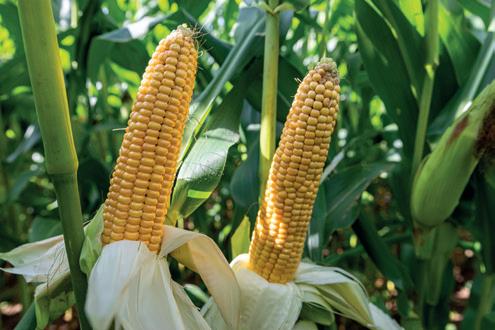
Top: Maize can bring diversity to arable rotation
Above: KWS Anatasio has excellent standing power
Below: Maize favours a sheltered site, says Andrew Cook
gree of cold tolerance, they should not be drilled before soils have reached an even temperature to give the best possible establishment, says KWS maize specialist Thomas Turner.
"This is 8°C for light soils and 12°C for heavy soils for 3-4 consecutive days. If you drill earlier, you're likely to have poor germination, uneven emergence and reduced nutrient uptake germination, while drilling too late could delay harvesting, risk poor maturity and increase lodging risk.
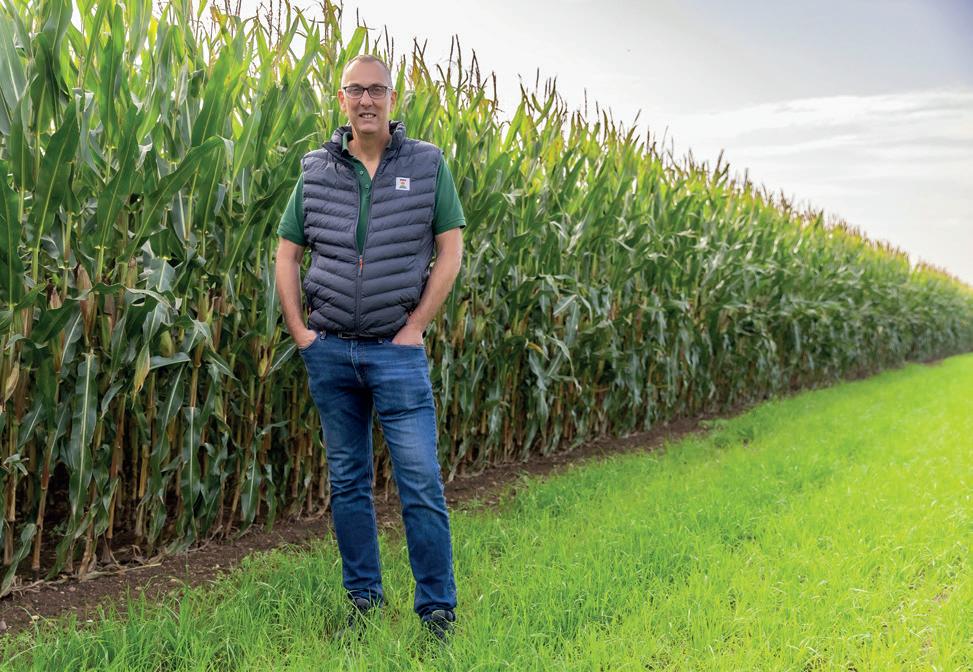
"Optimum drilling depth depends on time of planting with this being 3-5cm for crops drilled April to early May, 5-7cm from early May onwards and 7-9cm from mid-May onwards."
Starter fertilisers generally increase yields, improve the speed of establishment and lead to earlier ma-
“Nitrogen applications once the crop is growing are not usually needed, however, particularly if full use of organic sources has been made. The crop is unlikely to require much in the way of agronomic interventions, unless you are in area where maize eye-
There are several options complementary to maize production under
16 ANGLIA FARMER Arable
2019

JCB 531-70
6698 Hrs, 145 HP
7m Reach, 3100kg Lift
4 Wheel Steer Crab £44,000 +VAT
2021

JCB 532-60 1950 Hrs, 109 HP 3200kg lift, 6.2m Reach Tyres: 460/70R24 (80%) £59,950 +VAT

HE-VA 12.3M
620mm (24’) Cambridge & Breaker Rings with Brakes, 3m Transport Width, Sat System £31,950 +VAT








2016

MANITOU MLT 634
6577 Hrs
6m Reach, 3400kg Lift, 460/70R24 (30%) £36,000 +VAT

HE-VA 12.3M KING ROLLS 620mm (24’)Rings, 3m Transport Width £32,500 +VAT

HE-VA DISC ROLLER CULTIVATOR
610mm Discs, Soil Mats, 650XL, LED Lights £44,950 +VAT
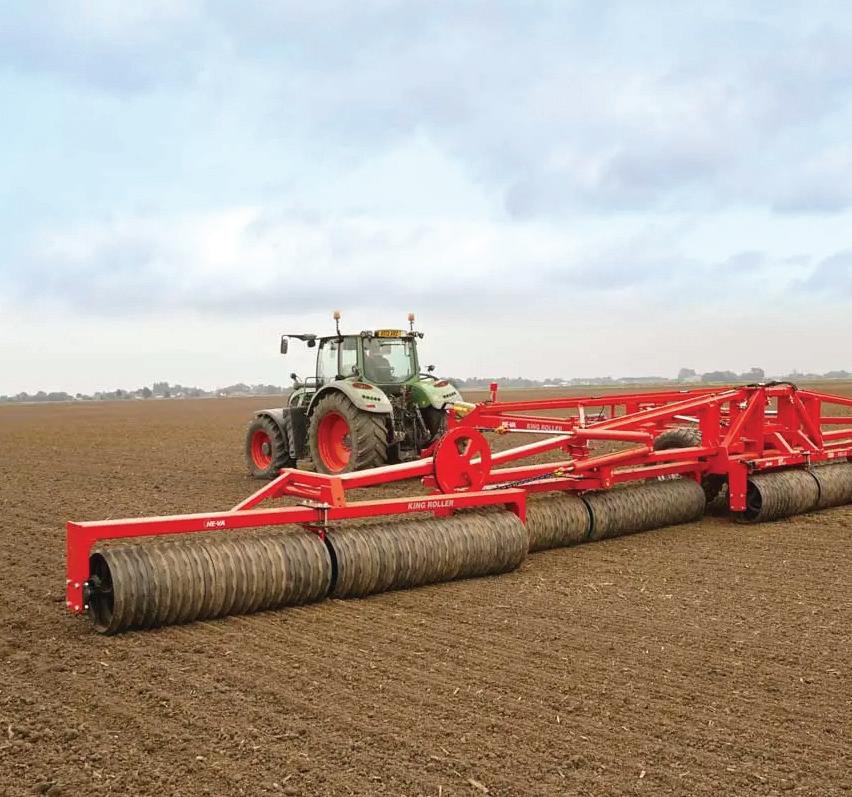
2009

MANITOU MLT 735 5000 Hrs
7m Reach, 3500kg Lift Tyres: 460/70R24 (40%) £45,900 +VAT

HE-VA 4M STEALTH SUBSOILER Folding Shearbolt, 8 Legs, Mounted, 600mm Profile £25,650 +VAT

HE-VA COMBI DISC CULTIVATOR Standard Legs & Points. LED Lights, Trailed £29,950 +VAT



2020 1500

MERLO TF42.7-140 1350 Hrs, 140 HP
7m Reach, 4200kg lift Tyres: 460/70R24 (95%) £69,950 +VAT

HE-VA 4M SUBSOILER
7 Legs, Shearbolt Protection On V Profile Roller, Folding £17,250

HE-VA STEALTH 3M SUBSOILER Auto Reset, 6 Legs Working Width 3m £19,850 +VAT


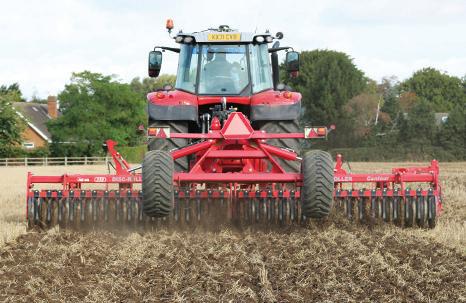


2017

MERLO TF42.7-4WD 5253 Hrs
7m Reach, 4200kg lift Michelin Tyres: (50%) £39,000 +VAT

HE-VA 8.2M ROOLS



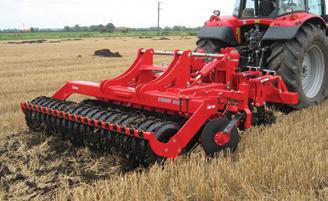




AN EXTENSIVE RANGE INCLUDING DISC AND STUBBLE CULTIVATION EQUIPMENT, SUBSOILERS AND SEEDERS.
ROLLS SUBSOILERS
ROLLERS SUBSOILERS COMBI DISC TILLERS SEEDERS
CAMBRIDGE
DISC
Errors and omissions excepted. All prices +VAT
&
STOCK www.chandlers.co.uk
HE-VA SAT-System A Spring Active Weight Transfer-System £7,850 +VAT 2004
NEW
USED
KING ROLLS XHD
NEW SCAN ME TO SEARCH USED MACHINES ONLINE www.chandlers.co.uk SALES | PARTS | SERVICE
NEW
NEW
+VAT
NEW
HOURS
LESS THAN
NEW
NEW
NEW CALL CHANDLERS AG SALES TODAY Graham Peall: 07970 121109 or Andrew Elms: 07860 464753




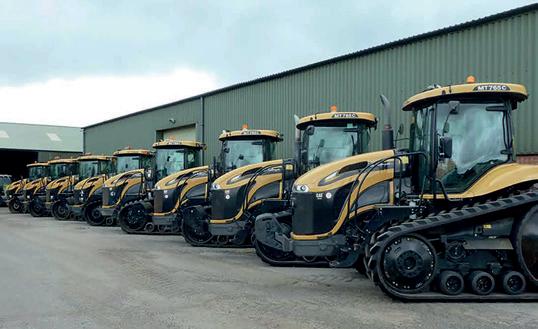



18 ANGLIA FARMER • MARCH 2024 The Sauerburger Condor Range
Ideal for stubble management and grass control.
For heavy duty rotary mowers up to 300hp.
Deep deck with mulching structure beneath aids even spread. • Multiple blade choices (standard, shredding & mulching). • Easy height and level adjustment. • 5mtr, 6.3mtr & 7. 3mtr. Simon Richard Ltd Crown Tailrig, Bonchester Bridge, Hawick, TD9 8RA Tel: 01450 860 774 Fax: 01450 860 772 simon@simon-richard.co.uk www.simon-richard.co.uk For heavy duty performance! Scan for Video Scan for Brochure Tel: 01507 466352 Mobile: 07801 343023 Fax: 01507 462812 Email: ian@ianhoulgrave.com THE LARGEST FLEET OF CHALLENGER TRACKED TRACTORS IN EUROPE up to 600hp FOR HIRE IanHoulgraveIanHoulgrave The CHALLENGER TRACTORS up FOR Ian Fax: on Bias tyres 5 year warranty on Farm Radial tyres 7year warranty Offering a wide range of agricultural and off the road tyres, Ascenso aims to provide long-lasting tyres that are specially designed for a variety of farming applications, keeping everything in mind including vehicle type, terrain, weather and user needs. For Ascenso Tyres in the UK, contact your local tyre dealer or visit www.ascensotyres.co.uk Trade enquiries: enquiries@ascensotyres.co.uk | 01205 743163 Agricultural | Industrial & Construction | Material Handling | Earth Mover | Forestry
•
•
•
Focus on crop nutrition to build root mass
• Multi-nutrient lift after wet winter
• Prolonged release kickstarts crops
• Trials show increase in root mass
Afocus on key nutrients could help to pull lethargic crops out of the cold, wet winter.
Without a strong root system to scavenge for nutrients and reach water as summer droughts take hold, no amount of fertilisers or other inputs will deliver vital growth and yield potential, says ICL agronomist Scott Garnett.
"With extensive trials showing a 35-40% increase in root mass resulting from use of the prolonged release multi-nutrient fertiliser Polysulphate, it's undoubtedly an approach practically all crops currently sitting in the ground could benefit from.
"Although many soils are still wet and cold, this will change as we ap proach the summer months. A short age of water is very likely and without a well-developed root system, plants will be under a lot of stress with lower yields and quality resulting."
Building blocks
Polysulphate's mix of 48% sulphur, 14% potassium, 17% calcium and 6% magnesium means it provides the building blocks for rapid root growth as well as addressing sulphur requirements, says Mr Garnett.
"It's also very visible in the physical root mass with markedly bulkier roots with more branching and much greater ability to utilise available water and nutrients. One more centimetre of root growth per plant touches an extra 130 tonnes of soil/ha."
Significant benefits
Polysulphate can be applied from February through to April at a recommended rate of 100 - 150kg/ha of product. As well as improved NUE and better roots, the low carbon mineral has been shown to deliver significant other benefits, Scott Garnett explains.
"It's a naturally occurring multi-nutrient sulphate fertiliser mined from under the North Sea and processed into an easy-to-apply product with excellent physical properties and performance right up to the widest spreading widths of 36.0m and more."

UK trials with Polysulphate have consistently shown yield lifts of 5 - 8% in winter wheat and as much as 33% in oilseed rape with a clear 0.5t/ha advantage over the commonly used NS products, says Mr Garnett
"Compared to NS products, it also gives growers the opportunity to separate sulphur out from their nitrogen applications. In NS products, both nitrogen and sulphur are locked together in a fixed ratio and this can be a problem.
gen which may not be desirable, especially in the current very wet soil conditions, when leaching can be an issue.
"Applying Polysulphate means you can apply the sulphur you need with the precise amount of nitrogen required, which is better for both the environment and overall production efficiency."
"Polysulphate can be applied by itself or blended with nitrogen fertiliser to provide the precise N:S ratio for an individual growing situation and to help farmers achieve 'little and often' applications."
Nutrient release
Trials by Nottingham University researchers have shown over 50% of the sulphur contained in Polysulphate is available in the first 12 days after application with the remainder released over the following 6-8 weeks.
Plants will be under a lot of stress
This matches nutrient availability precisely to crop needs through the growing cycle, which is in contrast to traditional NS products, where 100% of the sulphate is released within just 5 - 6 days after application, says Mr Garnett.
"This sudden release not only means many of the applied nutrients will never be taken up by crops, it also increases the possibility of soil nutrient loss and potential environmental problems.
"The high sulphur content of Polysulphate is important in boosting ni trogen use efficiency (NUE) and im proving the quality of crops – but the potassium, calcium and magnesium also play a key role.
"If you want to develop a good root system you need calcium, magnesium, phosphate and some trace elements and these are the main components driving mitosis and the cell growth required to build a good, strong and healthy root system.
"Phosphate is usually fairly abun dant in the soil, but adding calcium and magnesium can really kickstart root growth and this holds true across a range of crops including wheat, bar ley, oilseed rape and maize.
Mr Garnett says phosphate uptake by plants correlates with root health – and ICL has consistently seen this rise by up to 40% after Polysulphate application.
"If you want to meet the crop's sulphur requirements using NS products, for example, you're often also applying a sizeable amount of nitro
"Polysulphate also has the lowest carbon footprint of all equivalent fertilisers at just 0.034 kg CO2e which is less than 6% of the carbon footprint of nitrogen sulphur products."

Arable
MARCH 2024 • ANGLIA FARMER 19
“
Polysulphate delivers extra 30-40%root growth(below right) says Scott Garnett
Clean sweep for Crusoe milling wheat in YEN awards
Variety favoured by growers for consistent yield and quality
Three crops of Crusoe milling wheat grown by three different growers claimed the top three positions in the latest Yield Enhancement Network competition.
Breeder Limagrain said the victory was welcome recognition for the Group 1 variety which has established itself as a favourite among growers and millers due to its consistent yield and quality performance across different seasons.
First place for harvest 2023 went to Richard Budd, of Stevens Farm (Hawkhurst Ltd). Mr Budd grows 220ha of Crusoe in Kent and Sussex. The farm’s focus is on quality Group 1 and 2 wheats for local mills and export markets.
“We’ve only been growing Crusoe for three or four years,” says Mr Budd. “So far, it has served us well. It's yielded well, is relatively clean and easy to manage, stands well and has a good specific weight, protein, and Hagberg. It’s a solid, stable variety.”
Milling premiums
With milling wheat premiums touching £72/t over feed earlier this year, and predicted to stay firm for the foreseeable future given tight European supplies, Mr Budd is cautiously optimistic for the 2024 harvest, despite a challenging start to the season.
“Admittedly, I’d like an extra 5% yield, but I understand UK flour millers may be less keen on that due to the potential protein dilution. We do need some new genetics in the Group 1 sector, but at the moment, Crusoe is our default variety.”
Mr Budd recognises the importance of early nitrogen to support tillering and biomass accumulation, Tissue testing is then used to refine later applications according to crop requirements.
He has seen good results from applying two large splits of 80-90kg N/ ha when conditions allow in February – and again in late March or early April.
Disease status
Mr Budd’s nutrition strategy is supported with a robust, preventative fungicide programme, tailored to dis-

“With our direct/ strip-till system, we find that if we can keep leaves 3, 4, and even 5 and 6 relatively clean throughout the year, they are still contributing quite a lot to final yield, right up to cheesy ripe stage.
“That said, we’re not applying maximum rate fungicides all of the time; decisions are guided by what’s there at the time, and varietal choice. I like Crusoe; it is a relatively easy, clean variety, with good Septoria scores, and yellow rust is non-existent really.”
Late-season brown rust is some-
We need to be looking more at genetics
thing to watch out for in some years,trol, with a good range of chemistry available, he notes. “As an industry,
Grain protein
Norfolk Crusoe grower Chris Eglington, who won gold in the 2022 YEN Milling Wheat Quality awards, claimed silver with Crusoe for harvest 2023. He recorded the highest grain protein of 13.7% and 78.2 kg/hl for his 10.5t/ha crop.
Mr Eglington says he valued Crusoe’s performance in what was a tricky 2023 season. “Yes, it’s been around a while now, but it’s great to have a variety that we know how to manage and
20 ANGLIA FARMER • MARCH 2024 Arable
Crusoe took the top three positions in the YEN milling wheat category
“


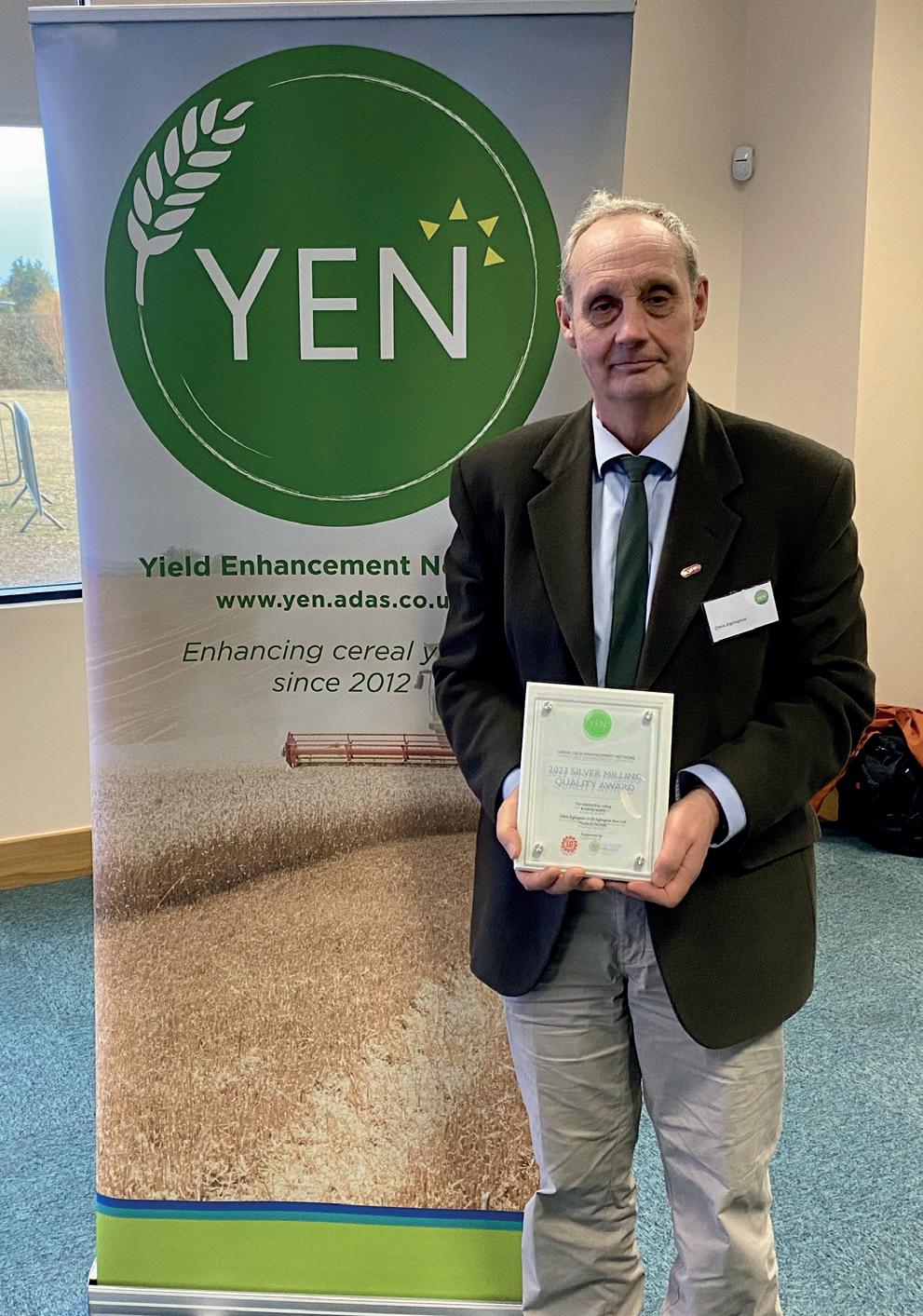
CarrierXThastheabilitytooptimise thediscanglestoitsworkingdepth. Thiscreatesafullcut-outata shallowerworkingdepthorreduced soilflowatadeeperworkingdepth. Bothofthesefactorscontributetoa lowerdieselconsumption.
Learnmoreatvaderstad.com
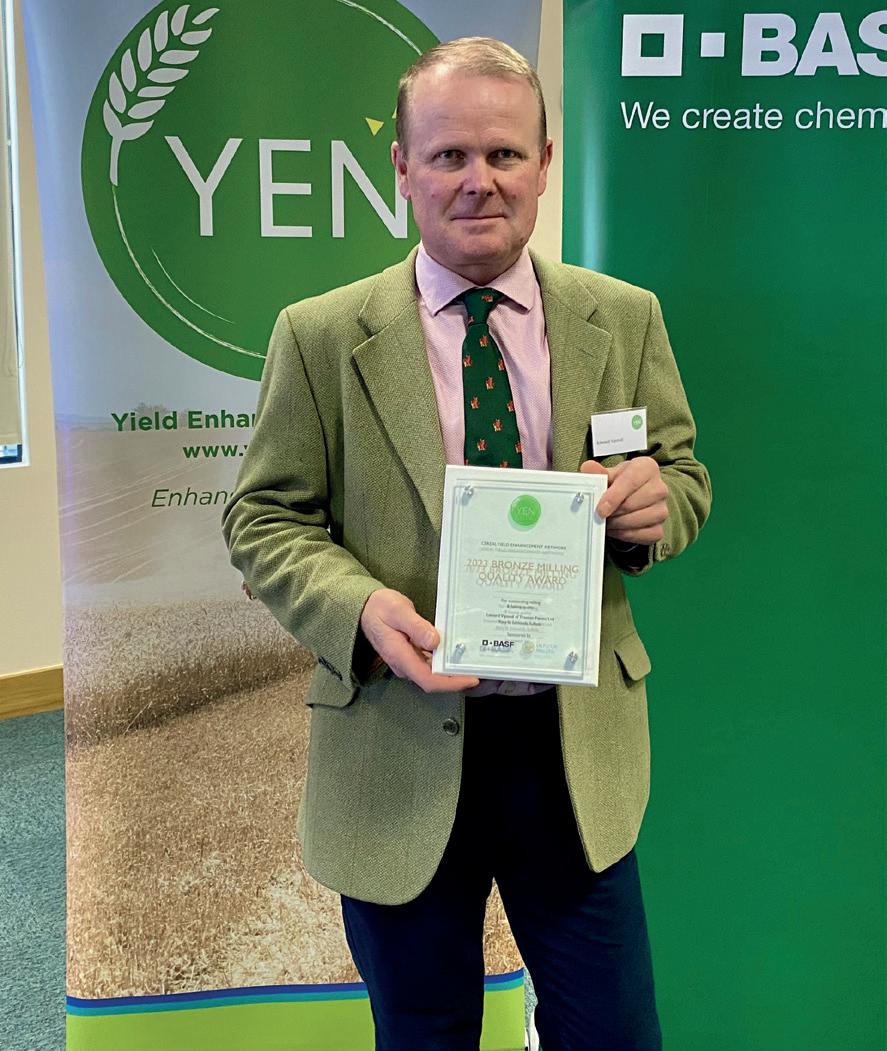
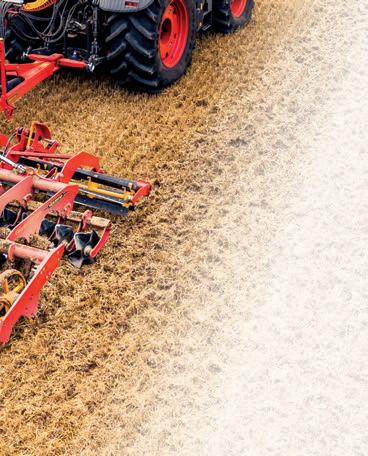
CarrierXTcaneitherbedelivered asatrailedormountedversion. Theworkingwidthis4.25,5.25or 6.25m.AllCarrierXTmodelscan beequippedwitharangeofboth singleanddoublepackeroptions.







MARCH 2024 • ANGLIA FARMER 21
Wherefarmingstarts
First placed grower RichardBudd (left) with Chris Eglington (centre) and EdwardVipond (right)
Thenew CarrierXT
Summary of the top three YEN Crusoe wheat samples
ing premium, applying 270-280kg N/ ha for example, you need confidence that the crop will deliver in terms of protein, and Crusoe does that.”
Protein is as much down to the variety’s genetics as how you manage it, adds Mr Vipond. Crusoe seems more consistent than other milling wheats grown on the farm, he says. “For us, even at yields of 10.5 t/ha, it will still regularly obtain 13.3-13.5% protein.”
Last season’s wet summer did pose
“
'Go-to' variety in first wheat slot
challenges for protecting quality, with milling wheats prioritised for harvesting slightly earlier than they might have been in a drier year, explains Mr Vipond.
This raised a few issues with thrashing on the combine, resulting in some unthrashed tips in the grain sample, but he insists the benefits of hitting milling specification far outweighed any drawbacks.
“There aren’t that many other com-



petitors in the Group 1 list at the moment. There are one or two coming in, but they’re yet to be proven and have got to do something special to knock Crusoe off. Crusoe suits our land and it delivers.”
Mr Vipond says flexibility is key to getting the best from any crop, particularly in terms of drilling date, seed rates, nutrition and other inputs. He generally drills Crusoe in early October to reduce BYDV risk, opting for seed rates of around 325-350 seeds/ m2
There is no fixed cultivation or drilling strategy though, instead the farm opts for whichever equipment suits conditions at the time. “Every sesson is different, so we do what is required.”
Some fields after potatoes or onions, for example, are established with a plough and combination drill, while others may receive a non-inversion deep tine (eg Sumo Quatro) before drilling with a disc or tine machine.
“Yield is still king, and if you can get decent yields of good spec milling wheat at a premium of £50-60/t, the return is still there. With the results we had from Crusoe last year, what’s not to like?”






Gold Silver Bronze Richard Budd Chris Eglington Edward Vipond Yield (t/ha) 11.9 10.5 10.4 Moisture (%) 15 14.4 14.1 Protein (%) 13.6 13.7 13.3 Specific weight (kg/hl) 76.2 78.2 76.9 Hagberg (seconds) 334 368 349 22 ANGLIA FARMER • MARCH 2024 Arable Grain storage and handling Steel framed buildings Groundworks All types of concrete Turnkey projects Phone: 01379 678459 Email: info@jhvaudrey.co.uk www.jhvaudrey.co.uk JH Vaudrey & Son Ltd Tel:01455891929 MI DBusinessCentre/SapcoteRd,Burbage,Hinckley LE102AU www.multiindustrialdoors.co.uk sales@multiindustrialdoors.co.uk •GalvanisedRollerShutters •PlastisolColourCoatedRollerShutters •InsulatedRollerShutters •SectionalOverheadDoors •Steel10PointLockingSecurity/PersonnelDoor •Steel Fire Exit Doors •Fast Acting High Speed Doors •Dock Leveller/Loading Bay Installations •PVC Strip Curtains •and many more products Na ti on w id e Serv ic e INDUSTRIAL DOOR Specialists Manufacture • Service • Installation
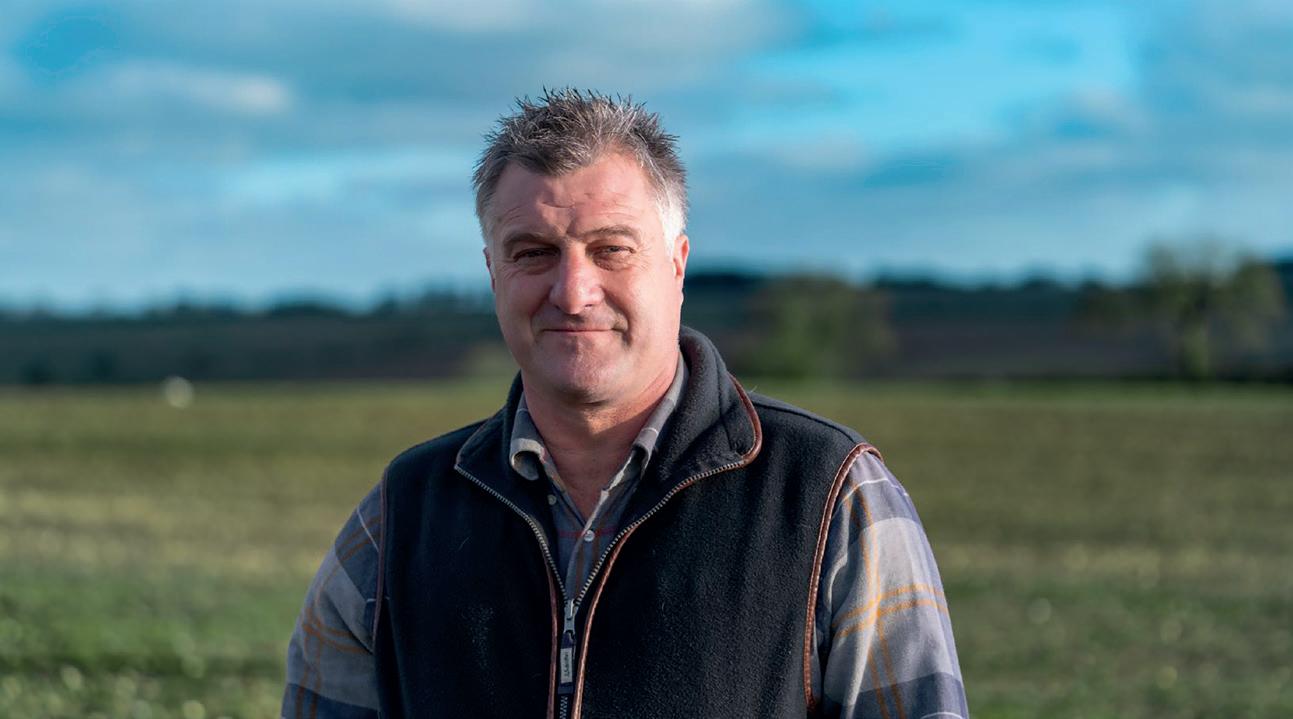
Skyscraper delivers gold for Lincolnshire grower
Attention to detail secures impressive yields
Abumper winter wheat crop saw Lincolnshire grower Mark Stubbs scoop top prize in the ADAS Yield Enhancement Network Cereals competition.
The 16.6t/ha crop of LG Skyscraper yielded an outstanding 16.6t/ha when it was harvested last year. It was second time lucky for Mr Stubbs, who last won the competition in 2019 with a crop of KWS Siskin that yielded 16.3t/ha.
Mr Stubbs puts his success down to an attention to detail encompassing delayed drilling, widespread use of farmyard manure and a move away from ploughing. “We find that the nutrition contained in the manures kicks in early on, giving the crop a good start.”
Crop rotation
Wheat is the mainstay of the rotation for A&C Stubbs & Sons who farm 688ha across two sites on the Lincolnshire Wolds and along the east coast. The winning wheat crop was grown on heavy clay at Marsh Chapel. Other crops include oilseed rape and spring barley.
Mr Stubbs says he has always been pleased with the Skyscaper's yields, which average 10.5t/ha. Grain quality is consistently good and specific weight is a priority, with last year’s crop delivering a very acceptable spec weight of 80kg/hl.
LG Skyscraper joined the AHDB Recommended List in 2019. Since then, it has remained a firm favourite on farm for its consistent high yielding performance across seasons, strong agronomics and suitability for later drilling for black-grass control.
“
Nutrition from manure kicks in early
Attention to detail and planning before the season begins is a key part of Mr Stubbs' approach. This starts with variety choice; he grows seed crops of new varieties, so is in a good position to see what varieties do well in the colder, exposed Wold conditions, or in fields along the coast.
The 2023 YEN winning wheat crop followed an oilseed rape crop that was allowed to green-up for as long as possible acting as a catch crop, before cultivating with a tine disc cultivator and packer, followed by a shallow disc cultivator.
Drilling dates
Wheats are generally drilled around the last week of October; however, last year it was very wet, so he waited a week, drilling the LG Skyscraper on 11 November, at a rate of 250kg/ha aiming for a plant population of 275 plants/m2 in the spring.
His aim – given the blackgrass legacy – is to produce a thick, competitive crop which has immediate access to nutrients, so that it can grow away strongly.
Optimising crop nutrition is important to achieve high yields. Manures are applied to stubbles and then incorporated within six hours. This has seen soil organic matter rise from an index of 2-10 despite the highly, acidic calciferous soils.
For the YEN crop, liquid nitrogen (225N,10%S) was applied in three splits, four weeks apart, and on average received 210kgN/ha, excluding the manure. “I don’t cut corners in terms of timing but will alter prod-
YEN success
Area: 3.2 ha (8 acres)
Variety: LG Skyscraper
Yield: 16.6t/ha
Specific weight: 80 kg/hl
T0 – Zonor + Scyon
T1 – Medax Max + Silvron Xpro + Firefly 155 + Starane Hi -Load + Ally max
T2 – Revystar XE + Tubosan
T3 – Deacon + Soratel + Kendo
Farm facts
A&C Stubbs & Sons, Manor Farm, Calcethorpe
• 695ha of owned, tenanted and farm business tenancy (FBT) land
• Winter wheat, winter oilseed rape, spring barley
• Haulage business
ucts according to the weather and disease pressure at the time.”
He favours a “little and often” approach, and in-season crop monitoring to fine-tune requirements. “We soil test and use the Yara N-tester to gauge how well the plant is doing and to address any shortfalls.”
Spray programme
A standard four spray programme was used for the LG Skyscraper. “ The variety has a weaker rating for Septoria (4.9), so it is important to tackle this early which means we are not chasing disease through this season, and in doing so we have never had too much of a problem,” he says.
“Despite being slightly taller-strawed, lodging in LG Skyscraper has never been an issue even on the more fertile Wold soils, but we use PGRs as and when needed, to support the crop we have in the ground.
“As last year’s crop was grown on the March site with heavier soils, crop emergence and growth were slower, and coupled with late drilling, the crop didn’t reach a leggy stage, so a robust T1 was used which proved sufficient to regulate the crop.”
He explains that a T0 was applied but with the key aim of manipulating the plant to ensure it was strong and healthy, and a bio stimulant was applied to boost the plant’s defence mechanism to fight any initial infections.
Harvest took place on 10 August –which Mr Stubbs points out was early for a late-drilled crop. “It literally turned overnight, it wasn’t ripe when we checked it two days before, so I think we caught it just in time.”
MARCH 2024 • ANGLIA FARMER 23
































24 ANGLIA FARMER • MARCH 2024 t: 01353 725 151 e: david@russellmillarltd.co.uk years experience in the roller shutter industry call us anytime for a competitive price. years40 inthe shutterindustry STEEL ROLLER SHUTTER DOORS UREASE INHIBITOR NitroShield Protecting your nitrogen Improves Nitrogen Use Efficiency Reduces ammonia losses by 70%+ Contact us today 01526 396000 Visit www.omex.com Email agriculture@omex.com www.needhamchalks.co.uk 01449 720227 GYPSUM SOIL CONDITIONER ALL GRADES OF AGRICULTURAL CHALK AND LIMESTONE COMPLETE GPS VRA SOIL ANALYSIS AND SPREADING SERVICE FIBROPHOS GRADES OF: 0-12-12 / 0-9-18 / 0-12-18 0-5-20 P-GROW 0-23-0 PKUP 0-23-0
Soil health
Soil study reveals benefits of regenerative agriculture
• Better for soil health and development
• Nutrients held longer around rootzone
• Benefits profitability and farm margins
Soil with minimal cultivation holds more nutrients and wa ter than fields which have been ploughed – benefiting crops and ul timately farm profitabilty, suggests a study.
The study conducted by research ers at University of Leeds Farm com pares soil health, crop production, greenhouse gas emissions, and profit of different farming systems across seven 12m x 40m plots.
Some plots were ploughed and pow er harrowed. Others underwent mini mal cultivation using non-inversion, shallow cultivation. Cover crops, liv ing mulches, manures, livestock inte gration and herbal leys were also as sessed.
Data was collected by state-of-theart soil stations created by Estonian agtech company Paul-Tech, which take real-time readings of nutrient avail ability, soil water levels and soil tem perature at depths of 8cm and 20cm.
Designed to shed light on the eco nomics of regenerative farming methods, each plot received three treatments of nitrogen throughout the trial. Nutrient and water availability was measured at both depths after each application.
Crop benefits

significantly smaller nutrient release at fertilisation and considerably less nutrients available to the plants at 8cm.
Project leader Ruth Wade said: “Results coming from this regenerative agriculture plot trial will provide important data on the impacts of different farming systems both on the environment but also for the farm business.”
The minimal cultivated plots recorded a significantly larger nutrient release after fertilisation and higher nutrient availability at a depth of
Soil temperature was also impacted by the cultivation method with the ploughed soil experiencing much larger temperature changes over the course of the trial.
The ploughed soil froze when air temperatures dipped below zero, whereas those sown under a minimal cultivation system maintained a much more stable temperature throughout and did not freeze.
'Fascinating results'
The study is ongoing and will look at the impacts of other regenerative tech-
“Min-till plots had better nutrient release
niques on soil health over a longer period. Paul-Tech chief executive Mikk Plakk, described the study findings as fascinating.
Mr Plakk said: “The data from our soil stations clearly shows soil nutrient availability and temperature differences between plots with different cultivation methods.
“For example, the soil in the conventional ploughed plot froze at root level and showed significant temperature differences while the minimal cultivated plots didn’t freeze and temperatures were relatively consistent in the root zone.
“Also, in the minimal cultivated plots, the soil was much more effective at holding water, which meant far more nutrients were available at 8cm than was the case in the ploughed plots.
“The findings have a significant bearing on how farmers should be treating soil. They strongly suggest cultivation methods have the potential to significantly improve soil and plant health while reducing the amount of inputs they need to apply.”
Cost savings
Paul-Tech’s soil station combines real-time proprietary sensor data with weather and satellite data to produce agronomic recommendations for farmers and growers, which are reported via an online dashboard.
Already in place on commercial farms in Scandinavia and eastern Europe, the system was launched in the UK in January. It means more informed decisions about crop inputs and irrigation, leading to better soil health, plant health, yield and cost savings.
“Getting access to real-time, high frequency data from the soil station was vital for this study and will be equally valuable for farmers,” said Mr Plakk.
He added: “This level of insight would not be available without the ability to measure water and nutrient movement throughout the soil, which our system has been specifically designed to do.”
MARCH 2024 • ANGLIA FARMER 25
Ruth Wade collects study on the impact of regenerative farming practices
Tough decisions lie ahead for flood-hit crops
• Extreme wet seasons leave difficult legacy
• Roots comprised by lack of oxygen
• Building early nutrition may be crucial
Growers are advised to assess soil conditions before deciding whether waterlogged crops are still viable – or fields should be left to recover for next season.
Tough questions may need to be asked when it comes to choosing between managing struggling crops already in the ground, redrilling fields altogether or putting in a cover crop to improve soil structure, say agronomists.
Exceptionally wet autumn and winter weather continues to pose serious difficulties, says Neil Watson, technical manager for Hutchinsons. While some early-sown winter crops are looking good, others have been hit hard, he says.
Crucially, when soils become waterlogged, this starves roots of oxygen, says Mr Watson. This causes them to stop functioning, preventing the movement of water or nutrients from the roots up to the top growth.
Knock-on effects
duction might be around 1,200/m2, producing 500-600 ears/m2, but in extremely wet conditions, particularly when waterlogging occurs close to emergence, tillering may be nearer half that.”
In severe situations, crops can also “cannibalise" nutrients from older leaves to support newer growth, causing early leaf senescence, says Mr Watson.
Roots often adapt to wet conditions by growing closer to the surface to facilitate gas exchange in anaerobic soils. Shallow rooting presents issues as the season progresses though, especially when conditions turn dry and crops need more scavenging ability for water and nutrients, he says.
“Without the foundations, you haven’t got the critical structure to build growth throughout the season.”
Different options
The first step is to assess the soil and crop condition in individual fields, identifying issues and crop requirements. Building early nutrition to boost root development and build biomass is crucial, and early nitrogen is one of the most important considerations.

“The first N-Min results for this year show there is less residual nitrogen in the soil than we’d normally see, primarily as a consequence of nitrate leaching, says Hutchinsons fertiliser manager Tim Kerr.
But it’s a quadruple whammy; there’s less nitrogen in the soil, less in the crop, poorer rooting, and reduced mineralisation due to the impact of waterlogging on soil microbes. We’re facing a very different scenario to previous years.”
Applying nitrogen in ammonium nitrate form is generally preferred as this is more readily available to plants than urea-based fertiliser, which must go through two chemical changes –
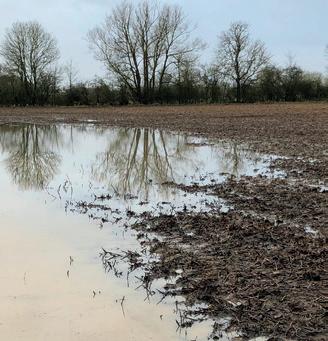

How waterlogging affects crops
Alters physical soil properties - e.g. reduced soil porosity and gas diffusion, leading to soil oxygen deficiency, limiting root growth and function
Consolidation of soil structure, making it harder for roots to penetrate and access nutrients
Impacts gas transfer from soil to roots
Compromises nutrient uptake

Denitrification (in saturated, anaerobic soils)reduces nitrate to nitrite which is toxic to plants and releases gases
Nutrient leaching, especially on lighter soils (particularly nitrogen, sulphur and boron)
Anaerobic conditions inhibit activity of soil microbes involved in many processes, including organic matter decomposition, mineralisation, N fixation
Shallower rooting = lodging risk and reduced nutrient uptake
Delayed or reduced tiller production
Anaerobic conditions cause mineralisation of organic sulphur to sulphides rather than sulphate
both reliant on microbial activityfor it to become plant-available.
“
You haven’t got the critical structure
“In normal conditions, plants are slower to respond to urea fertiliser, but if soils are in a less than ideal state, that process could be even slower. Inhibited urea is even slower to work, so be careful what you use.”
Soil nutrients
Early sulphur will also be important on almost every soil this year, as sulphate, like nitrate, is easily leached, Mr Kerr says. “Ideally, apply sulphur with the first nitrogen, or alongside the potash. Rates should generally be in proportion to the amount of nitrogen applied.”
Boron is another easily leachable nutrient, and testing of samples in recent years shows over 70% to be low in boron, especially on lighter land.
“Deficiency symptoms are rarely
Soil health
seen, but boron plays a vital role in root and shoot development. Trials in 2020 showed a positive response from foliar boron applied at GS 30 and GS 39.”
Potassium and magnesium are other nutrients to consider. They can be easily lost from lighter soils with a low cation exchange capacity, while phosphate availability may also be lower this year, not because of leaching, but due to losses from soil runoff in heavy rain.
“In cold, wet soils, the microbes that convert exchangeable P to available P slow down, so crops can quickly exhaust the soil solution, resulting in deficiency symptoms, even where soil indices are high,” adds Mr Kerr.
“Foliar products are an option if there is sufficient leaf area, however phosphites may be a more effective option to develop rooting and improve future scavenging ability.”
Manipulating rooting
Timely application of plant growth regulators could play an important role in manipulating crops to offset some of the damage done by waterlogging or flooding, says Alice Cannon, regional technical support manager for Hutchinsons.
“The power of PGRs is not just about straw shortening; the chemistry can manipulate crops in many other ways, depending on the product choice, rates and timing.”
Tramline and small plot trials last year, for example, showed early PGR applications at T0 (GS 30-31) and T1 (GS 32) can significantly improve stem diameter and stem width, boosting the plant’s lodging resilience – something that will be particularly important in shallow-rooted crops that may be more prone to lodging as biomass develops.
The same trial also found a bene-


compromised foundation period. The potential for fertile tillers is determined by the number of leaves present at stem extension, so keeping green area index going through March is crucial to building yield.”
Care is needed with product choice and rates on backward crops, she cautions, while more forward early-sown cereals might benefit from slightly higher rates.
“Growth stage 30 will be an extremely important timing this season. It’s traditionally a disease control timing, but it’s just as important to manipulate crops at this stage to maximise their potential.”
Disease control
While it is hard to predict disease pressure during the main growing period, certain diseases are likely to be at greater risk due to prolonged wet weather and lack of significant cold temperatures, so close monitoring and early action will be vital.
Mild, wet, conditions have fa-
Key actions
Assess fields to identify issues and decide on the most appropriate management Do test digs to asses the impact of waterlogging on soils and root development
Check plant populations to determine a realistic yield potential
Tailor inputs to crop need and yield potential, considering all available options Consider re-drilling or sowing spring cover crops on worst areas with no viable crop

crop management.
“Wet soils may increase take-all spread, and mildew is likely to be a greater risk in stressed crops, perhaps more so in barley, where risk from the rain splash diseases net blotch and rynchosporium are also likely to be greater.
While more backward, later-sown wheats may face lower Septoria pressure, later drilling does usually increase rust risk, and with a lack of hard frosts to kill inoculum so far this winter, rust could be a challenge in some situations, says Mr Howard.
“Ironically, we might see some benefit where flooding has taken away the lower leaves that can carry rust or Septoria spores over winter, but that will be balanced against the damage flooding’s done to crop stress and development.”
It’s a quadruple
Early action at T0 and T1 will be crucial, with fungicide choices tailored to the specific needs of individual fields, Mr Howard says. He also notes previous trials that have shown good results from using elicitors around
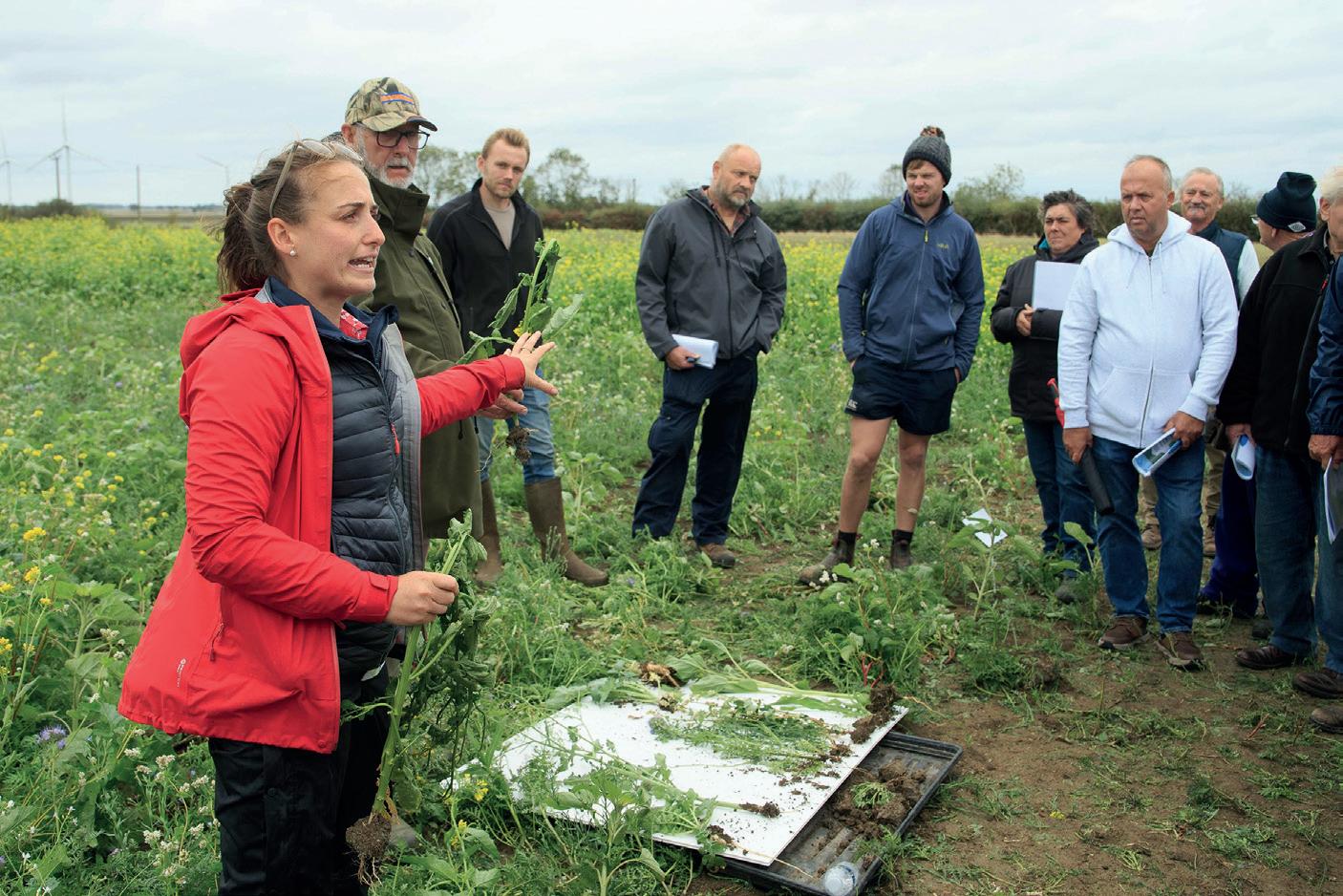

“
How monitoring soil carbon content can boost productivity
Measuring soil carbon content is providing growers with valuable insights for farm management – while helping to generate income from the government's Sustainable Farming Incentive.
“There's so much evidence of a direct and linear relationship between soil organic matter and soil function that carbon content is rapidly becoming one of the most important management KPIs in crop production,” says NRM agronomist Allison Arden.
“It is an essential indicator of a farming business's overall viability and production potential, but there are wider implications of developing management practices that build soil carbon content too.
At farm level, improved soil carbon content is linked to a multitude of benefits, says Ms Arden. These include better soil structure, more efficient key nutrient use, improved mois-
ture retention, healthier soil biology and greater overall resilience.
“Soil carbon content is a very good starting point in itself but there are many associated areas that give additional insight into what is really happening in the soil.”
Natural assets
Many people use NRM's CarbonCheck system to evaluate the natural assets across their farm to get a handle on their existing carbon stocks and to start their own carbon capture journey, adds Ms Arden.
“Those joining the new SFI scheme also use the analysis to ensure they meet their soil action obligations and have supporting evidence for their claims.
“But the ones that benefit the most are definitely those that use the service beyond this and realise it's an invaluable tool in helping them fine-
tune their management, reduce input costs and improve crop production efficiency.
“Measuring a range of parameters associated with soil carbon content is a very effective way to monitor soil health and production potential.
“Benchmarking on-farm results to national and regional best practice then allows producers to make the most informed decisions about adopting and integrating more long term sustainable farming practices.
“CarbonCheck measures organic and active carbon as part of a comprehensive suite, as well as total carbon, inorganic carbon, carbonate classification and bulk density.”
This not only gives details on traditional information such



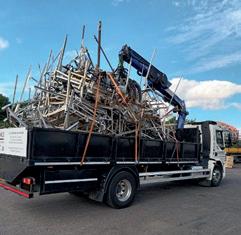


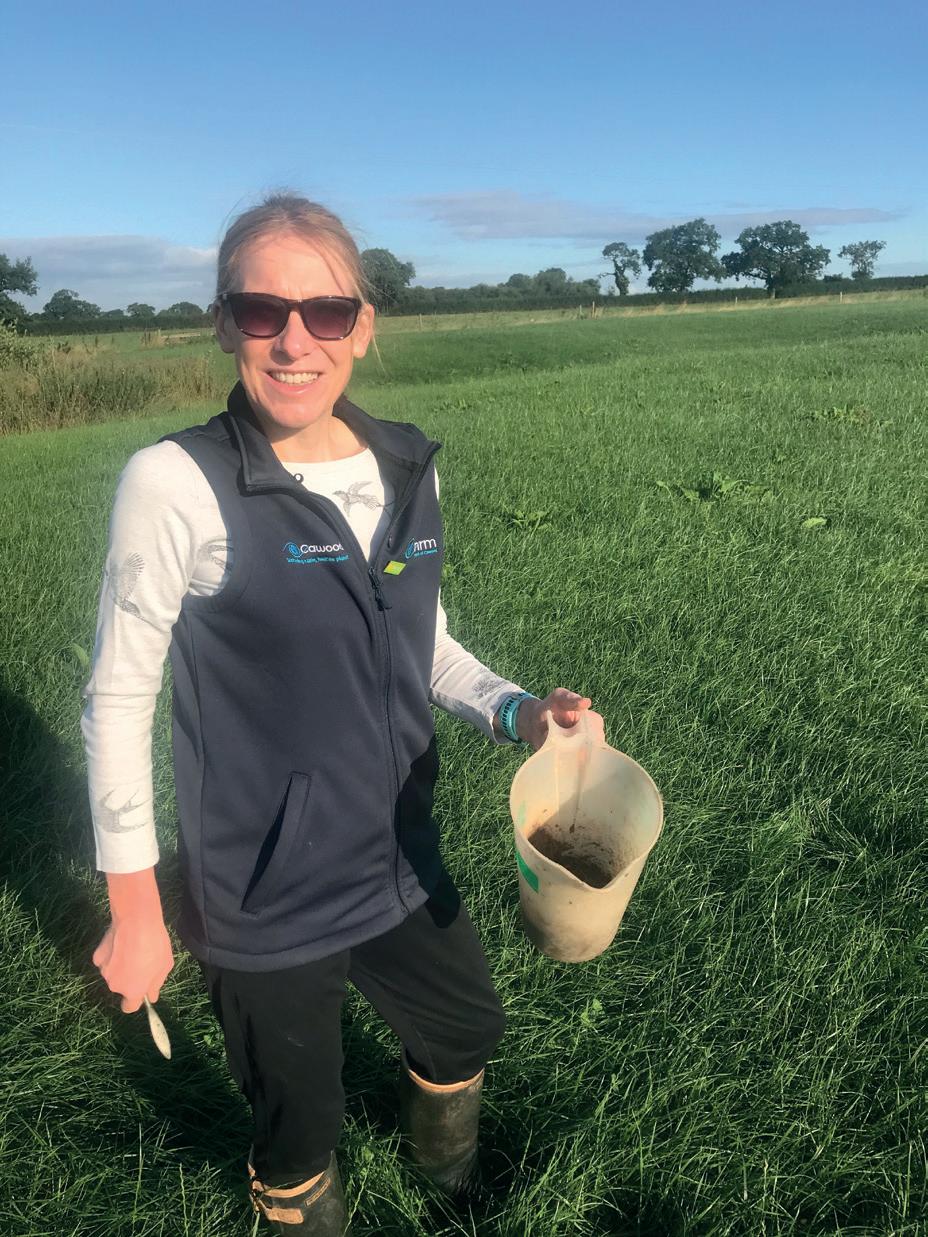


28 ANGLIA FARMER • MARCH 2024 Soil health
Mob: 07944 620339 Office: 01473 240429 fjmetals@btinternet.com www.fjmetals.co.uk BEST PRICE PAID FOR ALL SCRAP FARM MACHINERY Plant, silos, tanks, combines, tin wire, batteries, irrigation pipes etc Prompt dismantle & collection service Enviro regd merchant

as organic matter, but combines information from a number of different carbon measurements, total nitrogen and the C:N ratio, explains Ms Arden.
“Active carbon, for example, is a management tool that looks at the readily available portion of soil carbon that provides the immediate food source for soil microbes that is easily digested and turned over by the soil microflora.
“Importantly it's also the precur-

sor to building humus-type organic matter which is the type that can really lock away carbon in a more permanent state.”
Soil bulk density measurement is also an important consideration, says Ms Arden. “The denser and more compacted the soil the less effective the soil microflora are able to function and process organic inputs and residues.
“The better structured and more open the soil texture, the more efficiently the biology can work and the better it can turn over and recycle key nutrients.
“Carbon to nitrogen ratio is also an increasingly important area to look at with regard to crop nutrition particularly when aiming to get the most out of every kg of nitrogen from environmental, crop production and cost perspectives.
“The proportion of organic carbon relative to nitrogen gives an indication of the right balance for soil microbes to aid the release of nutrients with the optimum C:N ratio for nitrogen release being between 10 and 12.
“So again, it's a great example of how managing and improving the carbon content of soils can have a signifi-
cant effect on cost-effective use of inputs and overall productivity.”
Soil types
Whilst there is a lot producers can do to build carbon content from a management perspective, some areas are less flexible, says Ms Arden.
“One of the key drivers behind how easily you can build soil organic content is the type of soil and in particular the clay content.
“Clay content does drive organic matter and generally speaking we know grass-based production systems on more medium to heavier soil types have the most carbon and organic matter in them.
“In arable soils in areas like East Anglia, where much of the arable land is lighter textured, organic matter can be as low as 1 - 2%. Drier soils tend to be lower in organic matter too.
“According to AHDB, using green composts as your organic fertiliser source can lead to a 25% improvement in soil carbon levels in nine years; the same improvement can be achieved from FYM in 20 years and 20 years of using livestock slurry results in just a 7% change.”


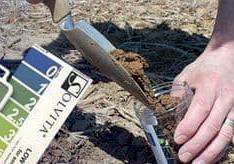





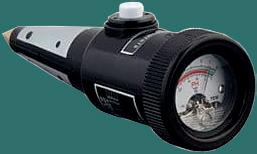



MARCH 2024 • ANGLIA FARMER 29
01452 741112 www.agrisupplyservices.co.uk info@goldingham-contracts.co.uk Soil Health, Manure & Compost Testing Compaction Testers Nutrient Testing PH Meter DM-5
Carbon content linked to 'multitude of benefits', says Allison Arden (left)
25-04-2019 27/04/2019 15:39 Page 2
11007 PROFTI AD 25-04-2019 _11007 PROFTI AD















































30 ANGLIA FARMER • MARCH 2024 Call us on 01284 747292 or email admin@4xtrahands.com Farm Recruitment Looking for staff? Looking for a job? 4Xtrahands.com 30630 Masterfarm open day advert Anglia Farmer mag.indd 1 19/12/2023 09:56 Call us today 01787 228450 or email enquiries@masterfarm.co.uk www.masterfarm.co.uk Bures Park, Colne Road, Bures, Suffolk CO8 5DJ *Applicable to both new and refurbished driers purchased on our open days. Full T&C applyavailable on request. 6th&7th 2024 8am-5pm 6th&7th 2024 8am-5pm All profit from the sale of our one-of-a-kind PINK GRAIN DRIER will be donated to Come and see the UK’s ONLY pink grain drier! Please join us either day, when complimentary food and drinks will be provided along with a host of fun activities including axe throwing, archery and airsoft target shooting! To register your interest, please call 01787 228450 or email enquiries@masterfarm.co.uk www.masterfarm.co.uk Bures Park, Colne Road, Bures, Suffolk CO8 5DJ 30630 Masterfarm open day advert Anglia Farmer mag.indd 1 19/12/2023 09:56 Pedrotti Master Driers are suitable for handling all types of materials and can deal with different climate conditions and cropping systems worldwide. With 15 basic capacities and with specific alternatives to meet individual requirements, the Pedrotti Master Drier is suitable for most applications. All new machines carry a 3 year factory warranty. The exceptionally high standard of construction makes them durable giving a strong demand for second hand machines Anglia Farmer YO UR FIELD IS OUR FIELD To find out more about our farm profiles contact our farming team o n 0 1 5 0 2 7 2 5 8 6 6
More farmers measure soil organic content
Almost one in five farmers now test their soil for organic matter content – with more growers recognising the importance of carbon sequestration.
Nearly 90% of farmers undertake some form of soil assessment, with 78% of those using three or more methods and 6% using six or more methods, according to a survey conducted on behalf of beef processor ABP and supermarket Asda.
Testing is usually conducted to quantify soil acidity, phosphate, potassium and magnesium levels. But more than 17% of respondents said they test for organic matter, with 8% counting earthworms and 6% measuring soil carbon.
Soil nutrients
The results suggest livestock farmers are increasingly concerned about the importance of balanced soil nutrients – and keen to understand the balance
within their soil, including soil carbon indices and its ability to mitigate cli mate change.
ABP agricultural projects manag er Liz Ford said: “Looking after soil correctly can minimise nutrient input requirements and extend the grazing season by improving the pasture’s re silience to drought and reducing flood risk.
“Earthworm populations are indic ative of soil health and can be moni tored by digging small field pits and counting the species of worms at dif ferent depths. We are pleased to see that some farmers are already doing this.”

The voluntary survey of 250 farmers sought to demonstrate their commitment to improving biodiversity. It found that the combined length of hedgerow managed on their farms stretched to more than 1,900km.
One respondent reported more than 80km of hedgerow on his farm, with

Following the success of the trailed versions of the Progressive Cultivator, we are pleased to now offer a more costeffective alternative.
A fully mounted model
which suits larger horsepower wheeled tractors and smaller tracked machines.
www.keeblebrothers.co.uk

Soil organic matter and worm numbers are increasingly important
the average farm supporting 8km of hedgerow. More than half of those surveyed had recently planted an average of 869m of hedgerow each.
Farmers were also asked to rate the importance of biodiversity to their farm using a score of one to ten, with one not important and ten very important. The average score was 7.63, with nearly 20% of farmers scoring it a 10.

Comprising of Discs, new Low Disturbance Tines and an all-weather compatible Packer.
Trialled in 2022; in some cases it outperformed the larger trailed versions on output and cost per acre basis.
Call now for more details on the
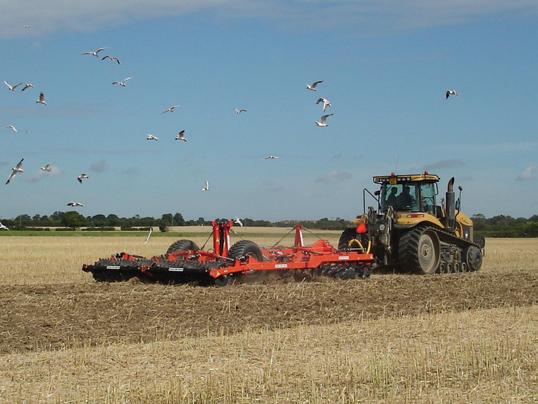
“The best kept secret in the South East”
Soil health
321930
01245
Cultivators & Subsoilers 01245 321930 www.keeblebrothers.co.uk MARCH 2024 • ANGLIA FARMER 31

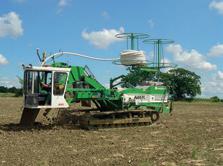

















32 ANGLIA FARMER • MARCH 2024 DRAINAGE (20) LTD • Agricultural & Amenity Drainage • Water Supplies, Mole Draining • Ditching & Ancillary Works Lodge Works, Great Ashfield, Bury St Edmunds, Suffolk IP31 3HA MEMBER OF THE LAND DRAINAGE CONTRACTORS ASSOCIATION TEL 01359 259424 FAX 01359 258073 www.milesdrainage.co.uk the Land Drainage Specialists TEL 01359 259424 www.milesdrainage.co.uk DRAINAGE LIMITED • Agricultural & Amenity Drainage • Water Supplies, Mole Draining • Ditching & Ancillary Works Lodge Works, Great Ashfield, Bury St Edmunds, Suffolk IP31 3HA MEMBER OF THE LAND DRAINAGE CONTRACTORS ASSOCIATION TEL 01359 259424 FAX 01359 258073 www.milesdrainage.co.uk the Land Drainage Specialists • Agricultural & Amenity Drainage • Water Supplies, Mole Draining • Ditching • Utility Installation trenchers@miles drainage.co.uk Celebrating OFTRADING EXPERTS IN ALL AREAS OF WATER MANAGEMENT COMPLETE DESIGN & INSTALLATION SERVICE TRUSTED BY LANDOWNERS & FARMERS WORKING ACROSS EAST ANGLIA & FURTHER AFIELD williammorfoot.co.uk sales@williammorfoot.co.uk Want to know more? Read or download our brochures at: 01362 820371 Call us on: Raising yields by unlocking your soil’s potential! HOW DOES INVESTING IN LAND DRAINAGE HELP YOUR FARM? IMPROVED TIMELINESS OF OPERATIONS AEROBIC SOILS WITH CONSISTENT PROPERTIES LOWER YOUR FUEL BILLS IMPROVE YIELDS Agricultural Land Drainage Contractors Anglia Farmer 2 R2.indd 1 03/03/2022 19:46 SEPARATOR SYSTEM PLUG & PLAY www.bauer-at.com SUITABLE FOR THE FOLLOWING APPLICATIONS: Agricultural applications: Separation of cow, pig and chicken manure • Food industry: Separation of vegetable waste • Slaughter houses: Separation of paunch content THE BAUER SEPARATOR CONVERTS SLURRY INTO A VALUABLE FERTILIZER. • Pharmaceutical industry: Separation of poppy seed mush Biogas plants: Before and after fermentation • Distilleries Adrian Tindall 07708 919597 a.tindall@bauer-at.com Rob Jackson 07939 410417 r.jackson@bauer-at.com
Water
Tax breaks needed to encourage water management investment
• Benefits to combat climate change
• Key proposals sent to government
• Productivity will rise, says report
Encouraging farmers to invest in water management will help combat climate change, the government has been told.
Better on-farm infrastructure and investment in technology is vital to mitigate the impact of increasingly unpredictable weather, said the Central Association of Agricultural Valuers in a submission to the Treasury ahead of this month's Spring Budget.
Nine recommendations are included in the 16-page document. They urge Chancellor Jeremy Hunt to consider a number of options to make farming more productive, efficient and able to adapt to current and future demands.
Farmers need to be able to adapt to climate change, and its resulting droughts, floods, storms and extreme heat, says the submission. Investment in reservoirs, irrigation and rainwater harvesting systems are all essential, it adds.
Water storage
It follows another winter which has seen farmland flooded for weeks on end. Flood management works, power systems to support farm operations and controlled environment storage are urgently needed, says CAAV secretary Jeremy Moody (pictured).
“We ask that a class of capital allowance be created so that critical improvements that would ordinarily be within the Structures and Buildings Allowance be treated as plant and machinery, meaning such investment can be written off in the year of expenditure.”
Other recommendations include an income tax relief to encourage letting of land and changes to inheritance tax to remove a bar to environmental uses. The paper also urges a review of cap-


ital allowances to stimulate investment in buildings.







“Our fundamental concerns are that the tax system supports farming in achieving a renewed pace of productivity improvement, and so contributes to economic growth and resilience,” says Mr Moody.


“In practice, this means enabling the most proficient farmers to have use of the land and to




support them in investing and innovating at this time of great technological advancement.”
While grant schemes are welcome, Mr Moody argues that longer-term changes to the tax structure will enable better use of private money to achieve the government's aim of greater capital investment in businesses.






'Simple changes could encourage investment'
A number of measures would encourage farming to be more productive – alongside investment in water management infrastructure, says the CAAV. Its nine recommendations include allowing partnerships and sole traders to benefit from full expensing – writing off investment in plant and machinery against profits – which companies can already do.
If not, the CAAV says the government should increase the Annual Investment Allowance in line with inflation. It has remained at 24.4% since 2019 – and limited to a maximum of £1m. It also argues that the Structures and Buildings Allowance (SBA) is unfit for purpose.
“Farm buildings are distinctive in the wear and tear they face, meaning they have shorter lives than found in other sectors,” said Mr Moody. “Obsolescence is also a factor with new
technologies, increasing standards and regulation, and changing equipment.”
Rather than writing agricultural buildings off over 33 years, farmers should be able to write them off over seven years, as is the case in Ireland, he said.
Investment in environmental improvement works should also qualify, including covered slurry stores and silage clamps, as should pig and poultry buildings and greenhouses, which are highly automated and can become outdated very rapidly.
“The urgent challenge of improving productivity, the need to respond and adapt to the impact of advancing climate change, and the scale of required environmental improvement are such as to warrant a new approach,” said Mr Moody.
“Clear and simple stimuli within the tax system can be powerful levers for positive change.”
MARCH 2024 • ANGLIA FARMER 33
Thousands of hectares of farmland have been flooded this winter
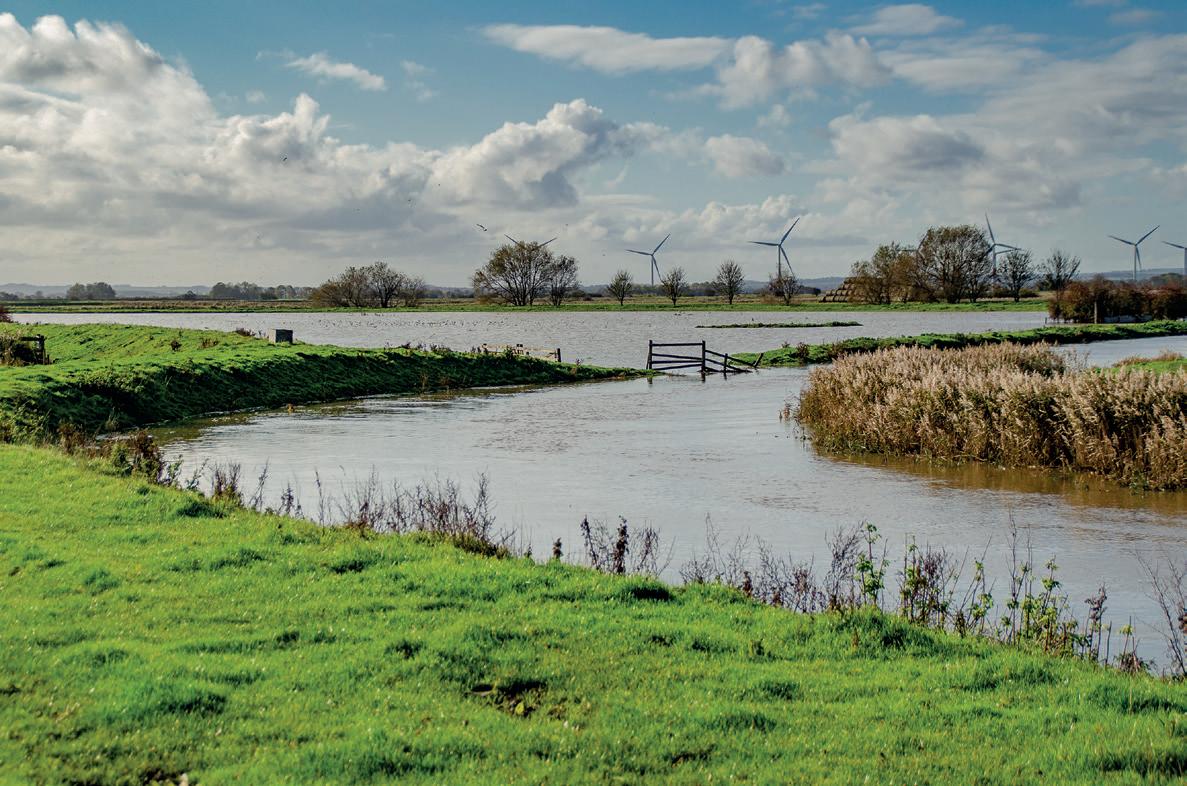
Agency acknowledges cost of flooded farmland
The Environment Agency says it supports farmers who want payment for flood water on their land – but not if the area is a natural floodplain.
Speaking at last month's NFU annual conference in Birmingham, Environment Agency chairman Alan Lovell said using land for water storage was a big issue – and in some locations it was the best way to protect local communities from flooding.
Storing water on farmland was often provided at great cost, acknowledged Mr Lovell – and it was understandable that farmers wanted to be paid fairly doing so, with agreements put in place to enable it to run smoothly. But he also sounded a note of caution.
Mr Lovell said: “We will support where flood storage areas are seen to be appropriate as part of a flood risk management solution. But to be clear, we can’t use public flood money for areas that are already natural floodplains.”
Financial toll
Other routes – particularly through the government's Environmental Land Management scheme (ELMs) could support farmers – but
the agency was unable to use government flood money for it, added Mr Lovell.
That said, Defra secretary Steve Barclay had recently asked the agency to look further at the idea – and how it could work with local people, local groups and internal drainage boards to see where the concept could be taken further forward.
Mr Lovell said: “I know many of you have experienced devastating flood and drought events, and I know it can take a huge financial and emotional toll upon you and your families – including some devastating long term mental health impacts.
“We will never forget that. This winter has been appalling. I have been around the country a fair bit, including a 1600-acre farm in Lincolnshire, entirely underwater apart from the farm and farm buildings on a little island in the middle.”
Thanking farmers for supporting local communities during flooding, Mr Lovell said the three months of 2023 were the wettest since 2000 and the third wettest since 1871. Working with farmers was a vital part of the agency's flood management work, he added.
£25m boost for flood management projects
ome 40 projects across the country will receive £25m in government funding to reduce the risk of flooding.
The money was part of the government’s plan to increase flood resilience. Defra minister Robbie Moore said natural flood management – including wetland restoration, tree planting and other measures – would help improve catchments while slowing and storing water.
Mr Moore said: “It’s vital we use nature as an ally in our work to become ready for climate change, helping to restore the natural environment and protecting homes and businesses. That’s why we’re funding the biggest-ever investment in natural flood management.”
Work will focus on soil and land management – slowing and storing surface water runoff, while also reducing soil erosion and supporting agriculture. New woodland areas and hedgerows will support wetland complexes and the creation of new habitats.
Ponds and leaky barriers across watercourses will slow and store floodwater in the upper reaches of some catchment. Vegetation management and new woodland will intercept the flow of water as it runs downhill, reducing runoff and enabling water to be stored in the soil.
The announcement comes after a range of applications were submitted to the Environment Agency after the launch of the largest-ever investment in natural flood management schemes last September.
Reducing risk
Environment Agency chair Alan Lovell said: “It’s exciting to see such appetite for Natural Flood Management, recognising its value in providing not only benefits against flood risk but also wider support for nature recovery.
“The new funding builds on the government's £15m natural flood management pilot programme which ran until 2021. The Environment Agency is managing the new £25m fund with work taking place until March 2027.”
34 ANGLIA FARMER • MARCH 2024 Water
Few farmers are compensated when land is flooded to protect local communities






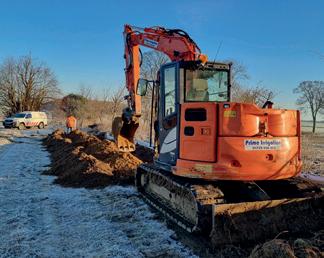
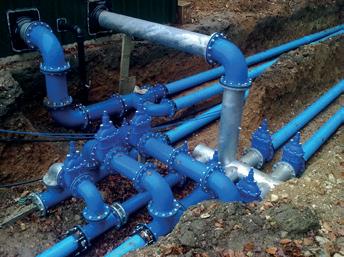

MARCH 2024 • ANGLIA FARMER 35 60 For 90 years, TW Page & Son Ltd has been serving the agricultural community of East Anglia • Borehole drilling • Submersible pumps for fresh water supply • Iron, manganese & nitrate removal • Reverse osmosis units • Ultra-violet disinfection • Water softeners • Water main laying & trenching services Contact us for a free quotation 7 Buxton Road, Frettenham, Norwich NR12 7NQ Tel: 01603 898071 Email: admin@twpage.co.uk Water Supply Engineers and Borehole Drillers Suppliers and Installers of Pumps and Water Treatment Equipment
Bauer introduces new E-series reel irrigators
New E-series reel irrigators from Bauer have several improved features to make them easier to operate and maintain.
The company has invested heavily over recent years to equip its Rainstar E-series with new digital technologies – including the Smart Rain remote monitoring and control app, says Adrian Tindall, Bauer UK & Ireland sales manager.
“Now, attention has been turned to some aspects of the mechanical components – mainly to improve access for servicing, maintenance and setting up to further improve the operator experience.”
Side guard
The most obvious visual change is to the side guard that covers the reeldrive turbine and gearbox – but less obvious is that instead of being held in place by ten bolts, the new version has catches that when released allow
the cover to swing away.
That makes it quicker and easier to access components such as the belt that transfers drive from Bauer’s water turbine to the pulley on the chain and sprocket that slowly rotates the drum to pull in the hose and either a rain gun or boom.
Opening the new cover also reveals a larger battery to power the Ecostar 6000 controller with its 4.3in LED touch-screen, which is supplemented by membrane buttons for the most frequently used functions.
“Users can store up to 12 different irrigation programmes that define retraction speed, pre-irrigation, post-irrigation and speed zones, and then retrieve them at any time to save having to enter individual parameters for every irrigation session,” says Mr Tindall.

adjust retraction speed, check on the status of the machine and receive error messages.
Remote access via SMS on a mobile telephone enables irrigation managers to not only stop and start the
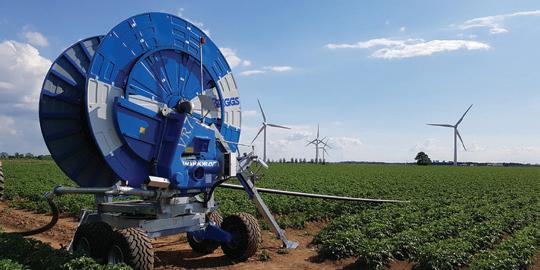




A ‘run finished’ message can be activated, and thanks to a digital input on the irrigator’s water meter, the Ecostar 6000 controller also records.












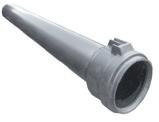


Water 36 ANGLIA FARMER • MARCH 2024
Rainstar new E series boasts some compelling new features
• Booms for lane widths 10 - 96 metres • Hosereels from 150 - 750m pipe length • Motorpump range; flow rates 30-150m3/hr • Raindancer remote monitoring & control • Fixtures, fittings, pipework and more... visit our website: briggsirrigation.co.uk call us on 01536 260338 or email: enquiries@briggsirrigation.co.uk WATER WHEN & HOW YOUR CROPS NEED IT The perfect fit for irrigation solutions Aluminium Fittings & Parts Contact John or Chris for your local Wright Rain dealer and a copy of our new brochure Wright Rain UK 2018, a quality name, providing a quality product. We are ideally placed to serve our dealers across the whole of the UK with our full range of aluminium pipes, fittings and parts available from stock. We specialise in agricultural and horticultural clear water crop irrigation and land dispersal of dirty water. The Wright Rain range of aluminium pipes and fittings are known all over the UK for their superior quality and durability, and have become the industry standard for many applications. Their light weight, strength and corrosion resistance makes them ideally suited for portable irrigation systems. Wright Rain UK 2018 Bawtry Road, Tickhill Doncaster DN11 9EX Tel: +44 (0)1302 756000
Drones help to redefine soil moisture monitoring
Radio waves could be used to measure soil moisture – helping farmers manage flood risk and make important decisions about irrigation.
A two-year project using drones carrying synthetic aperture radar equipment to make a high-resolution map of the earth's surface is being undertaken by experts at Cranfield University.
Led by Dan Evans, the project is assessing the accuracy and potential applications of the technology to improve the accuracy of soil moisture monitoring by obtaining detailed measurements at a field scale level.
“By mounting synthetic aperture radar onto drones, we can conduct comprehensive radar surveys of fields, providing us with detailed measurements of soil moisture.”
The project seeks to improve flood and drought risk management, helping farmers make informed irrigation decisions and plan for extreme weather events. The technology could also find applications in testing the stability of railway embankments.
Flood and drought
The project also aims to identify the effectiveness of radar-based soil moisture measure-
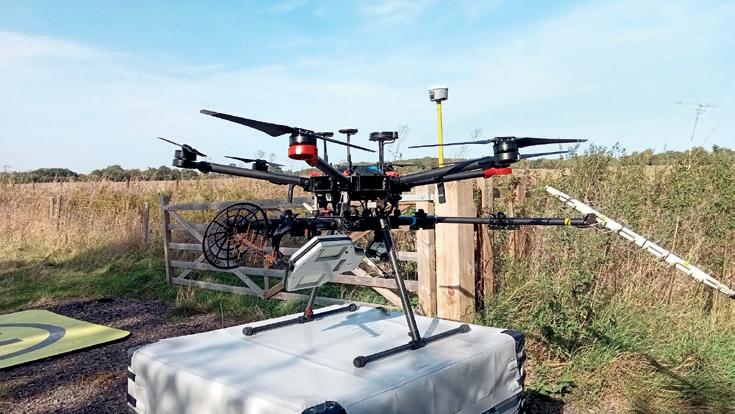
ments across different land use contexts, including grasslands, arable farmlands, and woodlands, says Dr Evans.
In addition to Cranfield University, the collaboration includes experts from the company Surveyar alongside other academic partners, with funding of £30,000 from the Douglas Bomford Trust.
Measuring soil moisture is often labour-intensive, time-consuming and costly. But the radar-equipped drones provide
a way of continuously and cost-effectively measuring moisture up to 40cm below ground – a critical depth for plant growth and yield.
While preliminary findings suggest that UAV-based radar is effective at assessing soil moisture, the project will investigate the impact that above-ground vegetation has on the accuracy of these moisture data across different land use contexts.
With increasingly warm summers and the threat of extreme weather events, Dr Evans said monitoring soil moisture has become crucial for optimising irrigation practices and mitigating the impact of flooding.

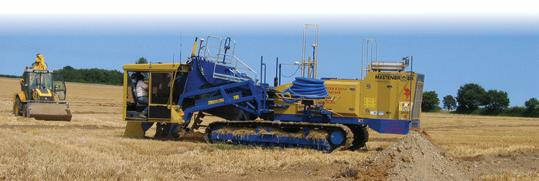

MARCH 2024 • ANGLIA FARMER 37
Measuring solid moisture using drones is cost-effective and accurate [photo: Dan Evans]
Agricultural Water Management Sustainable water resource management Abstraction licence renewals Borehole, reservoirs, surface abstraction, infrastructure, IT control Grant aid applications Reservoir planning, construction and management Water efficiency Water quality issues Contact: 01263 733395 07785 935498 andrew.alston@farmline.com www.awmcl.co.uk ALLAN COLLYER & SONS LTD land drainage contractors Precision farming requires precision drainage (with RTK GPS mapping and machine control) www.collyerdrainage.co.uk Cost effective land drainage Most modern equipment Excavations & precision levelling Contact Chris or Colin 01986 781404 High Street, Ilketshall St Margaret, Bungay, Suffolk NR35 1NA
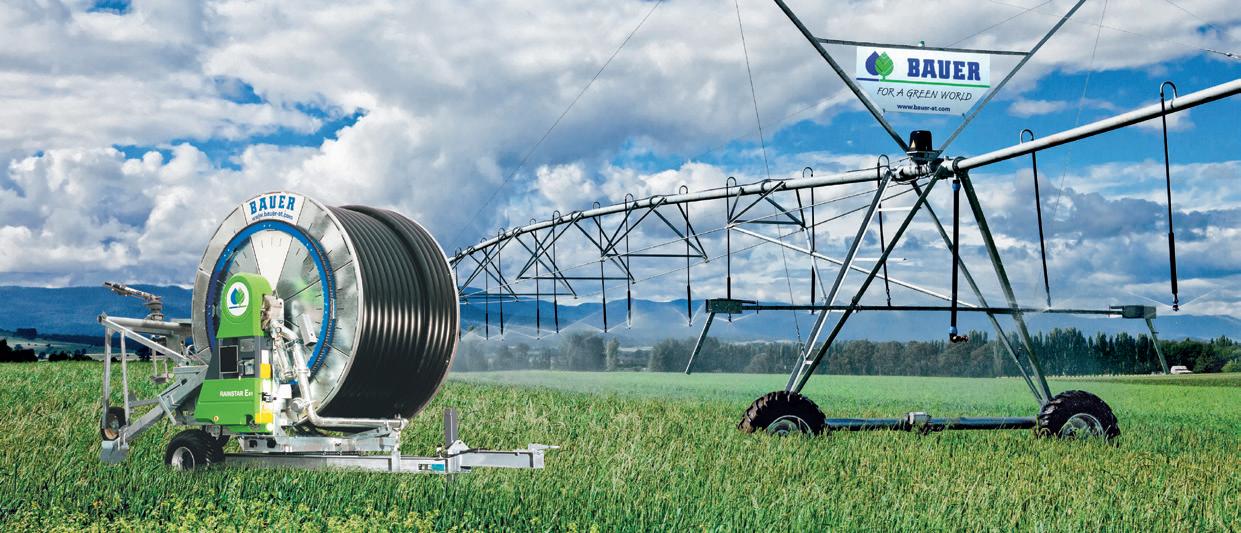

























38 ANGLIA FARMER • MARCH 2024 S C I E N C E I N P R A C T I C E Crop Rooter® Plus PROVEN PERFORMANCE Developed, Tested & Manufactured in the UK www ilex-envirosciences com/crop-rooter-plus @cropnutrition Röhren- und Pumpenwerk BAUER Ges.m.b.H. 8570 Voitsberg, Austria, Phone +43 3142 200-0, sales@bauer-at.com, www.bauer-at.com Mobile irrigation management system • Monitoring of Rainstar operation • Optimize your irrigation management • Automatic Error messages • Irrigation control via mobile devices • Team management • Automatic reports Contact Adrian Tindall: T 07708 919597 E a.tindall@bauer-at.com
Water
Drainage partnership celebrates anniversary
• Established for more than 20 years
• Makes light work of all drainage types
• Amenity projects –not just farmland
Two of the most recognisa ble names in UK agricultur al drainage are celebrating 23 years of working together.
The relationship began when DMJ Drainage managing director Darren Howell bought his first Mastenbro ek agricultural drainage trencher in 2001. The company has since grown into a multi-million-pound business employing 150 people.
Today, DMJ Drainage operates more than 35 trenchers, excavators, tractors, dumper trucks and gravel carts. With 12 Mastenbroek machines spanning drainage trenchers, gravel carts and ploughs, no other operator owns more of the Boston-made machines.
The Mastenbroek 45/20 plow was last used at Heneage Farm, Hainton, in the Lincolnshire Wolds. Some 14km of 80mm perforated land drainage pipe were laid to a depth of 900mm with porous backfill within 300mm of the surface – much faster than an ordinary trencher.
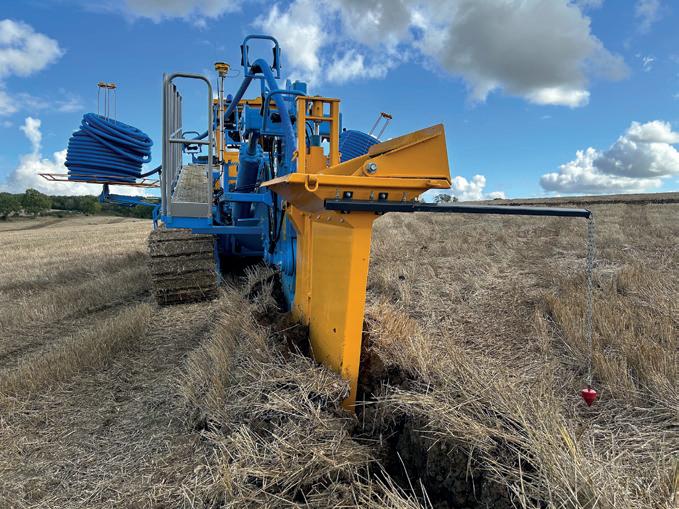
A recent project at Market Rasen has seen DMJ install 4km of 80mm perforated land drainage pipe at a depth of 800mm at 10m apart. This was then backfilled with 20mm gravel within 100mm of the surface.
Established in the UK in 1965 to sell and service Dutch drainage trenchers, Mastenbroek began UK production in Boston in 1977. Now 47 years later, the company's machines are used worldwide to deliver agricul tural drainage installations and utili ty cabling projects.
Race course
As part of DMJ Drainage's continued investment and reinvestment philoso phy, the company recently purchased a Mastenbroek 10/12D trencher after installing drainage on the race track for the Jockey Club at Southwell race course.
“The ground conditions were not suited to our Mastenbroek 30/20, which weighs about 20 tonnes and is not as manoeuvrable as the smaller eight-tonne 10/12D," says Mr Howell. “At the time, we didn't have the orders to justify buying our own 10/12D, so we hired one.
“I was so impressed with its per formance, the minimal contact area of the tracks, and how easy it was to move around the site that I saw an op portunity and bought one of our own. Since then, we've gone from strength
As well as leading to several racecourse projects, DMJ's 10/12D has allowed it to win work in other new areas such as caravan and leisure parks. It comes with a sports field kit, allowing excavated spoil to be transferred
Above and below: DMJ's single blade Mastenbroek 45 20 plough
“The Mastenbroek 45/20 plough features an EU stage 5 Volvo 13 litre, 462hp engine, which we calculate is using 35 litres of diesel an hour, which is amazing. As well as being incredibly fuel efficient, its wearing parts are much cheaper to replace than those on
The 45/20 plough unit, with its single link with slew and tilt control, features a replaceable cutting edge and point that can reach depths of up to 1.8m with six degrees of linkage slew either side of centre and 12 degrees of
Despite using a ripper leg to cut the ground, the Mastenbroek 45/20 plough has surprised DMJ in terms of the tidiness of the spoil it produces and the high-quality finish it leaves.
“The Mastenbroek 45/20 plow lifts the ground in formation, so all the spoil goes back in formation. We used the plow for one agricultural job and were amazed to see winter wheat thriving a few months after the plow had lifted the ground.”
As well as the quality finish and running costs, DMJ operators have also enjoyed working in a large cab, which is comfortable and convenient, with two doors allowing the operator
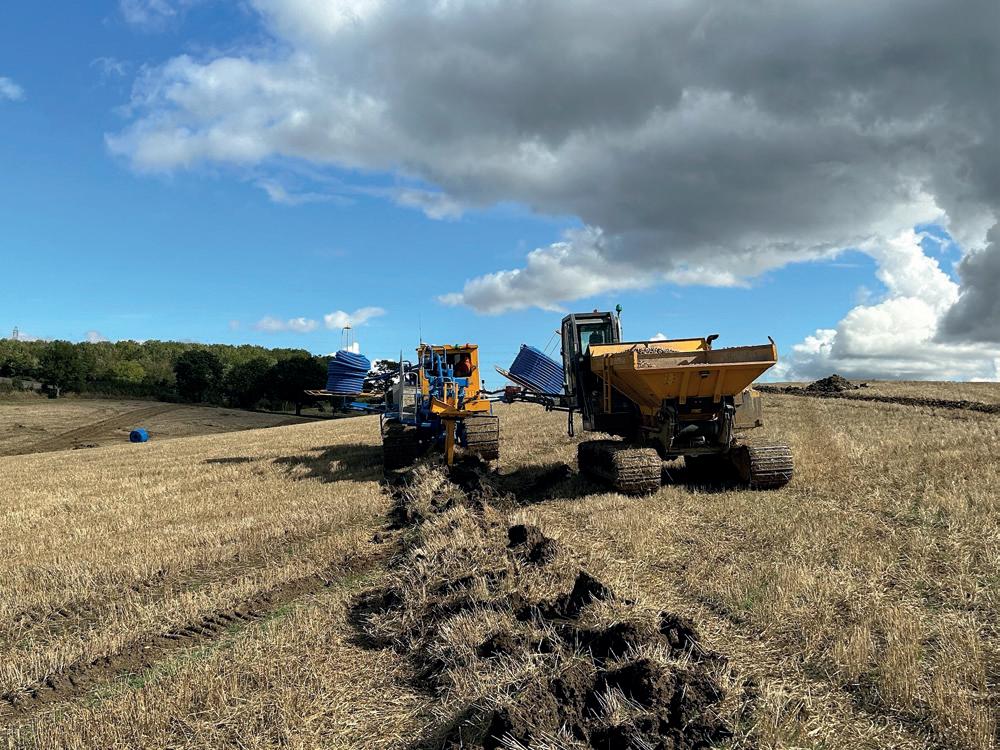
How cover crops help to protect water quality
• Nitrate leaching reduced by up to 90%
• Good for farm business and environment
• Success depends on destruction method
Cover crops can help to reduce nitrate leaching into watercourses by up to 90%, suggests a study, with destruction by chemicals proving most effective for optimising nitrogen availability to the following crop –and for reducing weed burdens.
ADAS scientists evaluated the impact of cover crops and different destruction methods on nitrogen release on crops on two farms. The Nitrogen release from Cover Crops (NiCCs) project was funded by Affinity Water and Portsmouth Water.
Trials were undertaken over two cropping seasons on commercial farms in Hertfordshire and West Sussex with two cover mixes and a weedy stubble control. The two cover crops comprised a mix of phacelia and oil radish; and a mix of Japanese oats, buckwheat and phacelia.
After being sown and grown, the two cover crop mixes were then destroyed. A number of different destruction measures were assessed: mechanical rolling on a frost; chopping and incorporating; and destruction by chemicals.
Outcome

Results identified that cover crops reduced nitrate leaching losses by up to 90% compared to the weedy stubble control. Depending on how well the cover crops established and the species mix, soil nitrogen supply to the following spring cereal crop also increased by up to 35kgN/ha.
When it came to the subsequent spring cereal crop, yields following a cover crop were up by 0.2-1.0 t/ha when compared to yields following the weedy stubble control. On destruction, the cover crops released significantly more nitrogen than the no cover/weedy stubble.
Moving to destruction methods, chemicals were found to have more benefits than mechan-
ical methods. Nitrogen mineral release, grain nitrogen offtake, and total crop nitrogen uptake were all higher with chemical destruction.
This led to subsequent improvements in yield – but it remains marginally more cost-efficient for farmers not to grow cover crops, although this could be overcome with financial incentives that reward better water quality, improved soil health and biodiversity.
Crop performance
“Cover crops can capture significant quantities of nitrogen over winter, thereby protecting surface and ground waters,” said ADAS principal soil scientist Anne Bhogal.
“It has been great working with Affinity and Portsmouth Water on this project which has given us new insights on how cover crop destruction methods can impact the subsequent release of this nitrogen and the following crop performance.”
Portsmouth Water, which co-funded the study, said the project showed that cover crops could help improve drinking water quality and supplies. This trial provides additional information that helps toward improving cover crop management and water quality, it added.
Two water companies help farmers plant cover crops
More than 1000ha of cover crops were sown last year – thanks to a joint scheme between Anglian Water and Severn Trent.
Supporting farmers to improve and care for rivers is also a central commitment of the Get River Positive programme – so collaboration with farmers is vital to Anglian Water’s work protecting and enhancing river health, says the company.
Pledges
The scheme pledges to transform river water quality across the two regions covered by the water companies. It has already supported farmers to protect water quality through its cover crop fund, which saw 1000ha of cover crops planted across eastern England last summer.
Anglian Water catchment advisor Julie Jackson, who is also a farmer, said: “Our region is particularly vulnerable to climate change, as the driest part of the country, and yet we also have a higher than average percentage of land used for agriculture.
Affinity Water catchment manager Danny Coffey said the company was working with farmers to find sustainable solutions which worked for both crop and water production. Trial data would be used to encourage the best outcomes for crops and water quality.
“The NiCC trial has shown that cover crops are a vital measure for preventing nitrate leaching and demonstrate how farmers can potentially manage the destruction of cover crops to best utilise fixed nitrogen for subsequent crops.”
Cover crops were chopped and then shallowly incorporated


“We know the impact of climate change – alongside challenges with costs and commodity prices coming down – is already hitting farmers, and with 75% of land in our region used for agriculture, it’s hugely important that we work together to protect England’s breadbasket.



40 ANGLIA FARMER • MARCH 2024 Water
Livestock
Welcome relaxation of bluetongue control zones
• Important remain vigilant for virus
•
Reduced levels of midge activity
• Warning for warm spring weather
Industry leaders have welcomed the relaxation of bluetongue control zones – but say livestcok producers must remain vigilant for the disease.
Temporay control zones that have limited the movement of livestock to control the spread of bluetongue were removed on 19 February – easing difficulties for many sheep and beef farmers in Norfolk and Kent.
National Sheep Association chief executive Phil Stocker said: “Due to a current reduced level of midge activity, some restrictions on movements of live animals from the temporay control zones have now been lifted.”
But farmers still face some restrictions to reduce the risk of the spread of bluetongue, added Mr Stocker. Defra has been operating with the aim of reducing the infection pool when the midge population rises in spring.
Risk remains
“There does remain a risk from infected pregnant females, due to the fact they can give birth to infected offspring, and from entire males as they can infect females either through nat-

ural service or through artificial insemination, so these animals are still restricted from movement.”
The relaxation means than any farm in a former controls zone that is as yet untested will be placed under an individual holding restriction requiring a vet attestation that any animal being moved is not pregnant, or entire in the case of males.
These animals will require negative tests prior to being moved. Castrated males and non pregnant females will be free to move to live and to slaughter.
Mr Stocker said: “Although this update is positive news and will relieve the burden for many, we are keen to encourage farmers across the country to remain vigilant and aware of the risk of bluetongue, especially as the weather warms up into spring.
“Although the current outbreak has been isolated to parts of Kent and Norfolk it is perfectly possible that the dis-
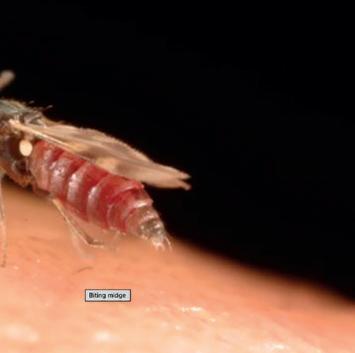
Defra says there is no evidence that infected midges are circulating
“
There does remain a risk

ease could be far reaching across the UK as the year progresses.”
Stay informed
The National Sheep Association is continuing to work with industry to ensure the sheep sector is well informed and prepared coming into spring. Farmers are encouraged to keep abreast of developments by looking for updates on the AHDB website.
Bluetongue is carried by midges. Defra said there was currently no evidence that the virus was circulating. Colder weather and the associated decrease in temperature meant midge activity was much lower with midges not actively feeding.
“Low temperatures also mean that the virus cannot replicate in the midge, so even if a midge does feed on an infected animal, the risk of transmission to another animal is very low. This is called a low vector period.”
'Be careful when it comes to movements'
The Animal Plant and Health Agency says farmers can resume livestock movements where there is no risk of disease spreading.
“Where there is a known disease risk, or unknown risk status, APHA will contact these premises directly to restrict specific animals within the premises,” says Aled Edwards, APHA head of field delivery England.
“APHA teams will continue to work closely with farmers to ensure that keepers and
businesses are kept up to date, and that questions and concerns are addressed promptly.”
Bluetongue does not affect people or food safety. The virus is primarily transmitted by midge bites and affects cattle, goats, sheep and camelids such as llamas. The midges are most active between April and November and not all susceptible animals show signs of the virus.
The impacts on susceptible animals can vary greatly – some show no clinical signs
or effects at all while for others it can cause productivity issues such as reduced milk yield, while in the most severe cases it can be fatal for infected animals.
Farmers are reminded that animals imported from bluetongue affected regions must be accompanied by the relevant paperwork to clearly show they meet certain conditions designed to reduce disease risk, such as correct vaccination.
MARCH 2024 • ANGLIA FARMER 41
FOCUS ON BEEF & SHEEP



























































42 ANGLIA FARMER • MARCH 2024 CHEALE MEATS PREMIUM TRANSPARENT FINISHED PIG CONTRACTS AVAILABLE NOW DIRECT FOR CULL SOWS AND BOARS 01277 811631 07711 719001 FREEPHONE 08085 300 303 • Refrigeration • Ambient Systems • Louvres or Flaps • Ventilation Ducts • Servicing • Grain Stores • Drive Over Floors • Fans • Heaters • Tunnels • Fan Houses • Automatic Controllers Collection throughout the UK. PLEASE CALL 0345 331 2747 www.envirotyre.com Collection & environmental recycling of agri, truck, industrial, car tyres & tracks. Suppliers of heavy-duty sidewalls for silage clamps. &TRACK

• Flagship beef show returns for 2024
• Best bloodlines and livestock classes
• New approach attracts more visitors
Beef producers from across the UK will gather at next month's Beef Expo show – the flagship event to celebrate the best of British cattle breeding.
Organised by the National Beef Association, the one-day exhibition is scheduled to coincide with Great British Beef Week – being held on 27 April at North West Auctions, at Junction 36 of the M6 motorway, near Kendal, Cumbria.
Beef Expo’s highly competitive show classes will once again showcase some of the UK’s best bloodlines. A panel of leading experts will address the most important issues facing the industry in an information-packed seminar programme.
Building success
NBA chief executive Neil Shand said he was keen to build on the success of the last Beef Expo – which was the first since the Covid pandemic and held on the other side of the country at Darlington Farmers’ Auction Mart in 2022.
Mr Shand said the 2022 event attracted a record number of visitors from across the country to the northeast. He added: “We’re confident we
have the right programme, venue and location to repeat this success in the north west.
“This is a highly productive part of the UK for suckler and beef cattle, and North West Auctions’ combination of experience, expertise, and exceptional facilities make this the ideal venue for an outstanding event.”
In a bid to attract more visitors, the event has been streamlined – to one Saturday only. Free to visitors, the event will focus on top quality cattle and the importance of sharing beef performance information.
Significant challenge
“Beef breeders and farmers are facing a very significant challenge in the transition of UK farming policy after Brexit,” said Mr Shand.
“The aim is to create a perfect platform for everybody involved in the industry to network, find out how to make the best of the grants and subsidies available, and recharge their enthusiasm and commitment.”
North West Auctions managing director David Pritchard said he recognised the importance of the event for beef producers – and was very mindful of the particular challenges faced
part of the NBA Beef Expo – will cast their eye over some of the highest quality UK cattle.
Northamptonshire’s Frank Page will judge the Native and Continental classes and the Supreme Championships. Meanwhile, Lincolnshire’s Jonathan Lyon will judge the Baby Beef classes, the Baby Championship and Young Handler classes.
The National Commercial Cattle Show will see some 120 head of cattle compete in the 10 cattle classes for steers and heifers with the overall winner taking home the Supreme Championship title.
Tremendous livestock
Mr Page farms 336ha near Elkington. The family’s cattle enterprise comprises 140 beef suckler cows, with Limousin x British Blue or British Blue x Limousin cows put to British Blue and Limousin Bulls.
“We have tremendous livestock here in the UK and I am looking forward to seeing the cream of the crop,” he said. “In terms of what I will be looking for, it will be well fleshed, stylish, correct cattle with good conformation.”
Mr Lyon farms 130ha near Bourne in Lincolnshire. The farm is home to 70 suckler cows and a flock of 140 ewes. The Limousin x and Belgium Blue x run with three pedigree Limousin and one Belgium Blue bulls.
“An animal which catches your eye when it comes into the ring, with a wide, square stance and a very good top line, I’ll be looking for good depth in the hind quarter and whether it’s a calf or a bigger animal it needs to have a good, full loin.”
by farmers.
“It is a privilege to be chosen to host it again here at our J36, Rural Auction Centre in 2024 and we are very much looking forward to working with the NBA to make it an event to remember for those who are both exhibiting and attending.”
MARCH 2024 • ANGLIA FARMER 43
Beef Expo will celebrate the best of British cattle breeding
Livestock | Beef & Sheep
steps to better surplus lamb growth
Rearing more surplus lambs makes economic sense, says Jessica Cooke
Sheep farmers with surplus lambs to rear over the 2024 lambing season are being encouraged to make the most of these newborns’ early life growth potential to boost flock returns.
Maximising lamb numbers sold per ewe is a key benchmark for a successful sheep farming enterprise. This mean rearing some third lambs and orphans off the ewe.
But with lamb prices currently trending 15% ahead of last year, rearing these surplus newborns quickly and efficiently yourself to potentially target an earlier premium market makes sound economic sense.
Feeding a good quality, proven ewe milk replacer alongside good husbandry practices will help you capitalise on the lamb’s inherent early life, pre-weaning growth potential and be able to wean plenty of excellent extra lambs as soon as possible.
When it comes to rearing surplus lambs successfully, it's important to follow five crucial steps for best results:
1 Don’t compromise with colostrum feeding
As with all newborn lambs, the first priority is to ensure every surplus lamb receives sufficient colostrum (50ml/kg liveweight per feed and a minimum of 210ml/kg liveweight within the first 24 hours). This feed provides essential nutrition, as well as the important antibodies to help newborns fight off infections.
2 Choose the optimum rearing system
Surplus lambs can be reared on milk replacer via bottle, through ad lib bucket feeding or with automatic machine feeding. The method you choose will typically depend on the number of surplus lambs you have and the facilities that you have available.
Using a bucket or machine means training lambs to suckle. Be patient. If removing a surplus lamb from the ewe, take it away at 24 hours old, then leave it for a few hours to become hungry before gently introducing it to the teat.
3 Replace ewe milk for higher growth rates
Feeding trials with ewe milk replacer at Harper Adams University College and Reaseheath College (2021) have demonstrated surplus
lamb growth rates of over 300g per day. All lambs weighed at least 10kg at weaning at 35 days of age.
Lambs reared on ewe milk replacer mixed and fed cold from about a week of age to weaning drink as much and perform as well as lambs reared on warm milk, according to additional work at Reeseheath College in 2023. This highlights the opportunity to rear extra lambs off ewes on ad lib cold milk where boiler heating capability may be non-existent or compromised.
4 Feed enough milk powder
A single lamb reared artificially to weaning (at an average of 35 days of age) will require a minimum of 9.5kg of Lamlac (equating to 47.5 litres of reconstituted ewe milk replacer).
5 Get your lamb husbandry right
Lambs reared artificially will need constant access to fresh, clean water at all times. Top quality creep feed should be readily available to lambs and be offered fresh at least once a day, with refusals being fed to older livestock.
Take care

FIntroduce clean, dry straw – preferably barley into racks. Don’t feed ad lib high quality roughage, for example hay, during milk feeding as this can depress concentrate intake and delay weaning.
For optimum rearing results, don’t keep more than 25 lambs in a pen and keep similar ages and sizes together. Lambs must also have access to a clean, dry, straw-bedded lying area which is well ventilated but draughtfree. Check your lambs at least twice a day.
Finally, maintain scrupulous hygiene protocols. For example, all feeding equipment should be thoroughly cleaned each day and disinfected twice weekly.
Jessica Cooke is research and development manager Volac, which manufactures Lamlac ewe milk replacer
with in-lamb ewe diets
armers are reminded to take extra care when formulating in-lamb ewe diets following reports of variable forage quality.
Results from more than 200 big bale samples provided by sheep farmers show average energy levels of 10.2 ME/kg DM, protein levels of 13% and a dry matter of 50%, says Bryn Hughes, national sheep and beef specialist at Wynnstay.
“There is a big range within the samples, with some low energy and low quality, while some are high quality. There was a lot of silage made in September which is variable, but some surprisingly good forage was made in the autumn.”
Forage analysis
Mr Hughes says ideally farmers should undertake forage analysis to understand the quality of their forage, so they can formu-
late a ration specific to their situation. If this is not possible, he advises that farmers should assume forage is 10 ME or lower.
“When formulating rations for in-lamb ewes, it’s important to consider the ewe's energy requirements depending on her size and the number of lambs she’s carrying. Once you know the value of the forage, you can make up the nutritional deficit with concentrates.
“When balancing the diet, there are several nutritional elements to consider. It is also important to look at the mineral profile of the diet, as it needs to contain calcium, magnesium, phosphorus and at least 125mg vitamin E as well as cobalt and selenium.
“The energy level of the cake should be at least 12.5 MJ to provide the starch and sugar required by ewes and contain a protein content of 18-19%, with at least 5% digestible undegraded protein (DUP),” he says.
44 ANGLIA FARMER • MARCH 2024
5
Surplus lambs can still grow at 300g daily
Professional services
Simpler approach to SFI can deliver bigger benefits
• Make easy wins your priority
• Identify simple farm measures
• Be realistic about crop yields
Atainable Farming Incentive – deliver ing bigger benefits for farm businesses and for the environment, say advisers.
“While 2024 has started with the promise of numerous new SFI options to be introduced during the summer, coupled to a mixed SFI/countryside stewardship scheme, there is much to gain from making a start with the scheme as it currently stands,” says Agrii consultant Paul Pickford.

“There is little doubt that Defra has succeeded in achieving one of their main objectives for the new SFI application service which is to make it quicker and more straightforward for farmers, but it's still a daunting task for many.
“With 2027 being the last payment under the old BPS scheme, it's important producers understand as much as possible about what SFI offers and how they can make it work as effectively as possible in their business."
Focus on the easy wins
The areas and business practices producers should act on first are probably things that are already being done, suggests Mr Pickford.
“To net £6/ha and an additional payment of £97 per agreement, all you have to do is test your soil organic matter and prepare a soil management plan on the nature of your soils and the risks they might be exposed to in the future.
“Most producers will be doing this to an extent anyway as part of the Red Tractor scheme and would also have carried it out under cross-compliance. Once you have done this, you also get access to a management payment of
£20/ha for the first 50ha of your land.
“Making an assessment of your hedgerows, size, width, height etc., will pay you £5 for every 100m. You can then cut them every year, as long as you cut them a little higher, or you can do this every second or third year for a further £13/100m.”
On the same theme is the annu al payment of £1,129 available un der SFI for completing an Integrat ed Pest Management (IPM) plan, he points out.
“Most producers will be doing this anyway as part of Red Tractor. It's similar for the nutrient management plan and, whether under the NVZ rules or the farming rules for water, everybody should already have one of these and it's worth £652 under SFI.
“Between management, IPM and nutrient management plans, there's just under £2,800 on offer within the scheme and that's a good start.”
Pinpoint priority areas
If you are going to put in new corners and buffer strips you will be taking land out of production and this is where things get a little more involved, says Mr Pickford.
ly making some good money, but there will be parts of that field, whether it's a boggy corner or a shady bit under a hedge, that might only be doing 5t/ha.
“Choosing to grow a pollinator mix, wildflowers or some winter bird food on that particular piece of land could not only make a more positive contribution to the environment, it would make you more money.
“Those three options will all make a gross margin of somewhere just over £550/ha which could be considerably more than you would have earned by growing 5t/ha of wheat."
Do your homework
In many cases, growers will know exactly where their least productive areas are but in some instances this may need a bit more investigation, advises Mr Pickford.

“If the average yield of a particular field is 10 or 11t/ha, then it's obvious-
“The bad bits are obvious, but the more marginal areas will need a bit more work to identify. If an area has always produced 4 - 5t/ha that's a given. But if it produces 7t/ha in most years and a bit more in some, that's
“Some of the benefits from looking at the finer detail may only be small, but at the end of the day it is the aggregation of these improvements that will make all the difference.
“Take the case of headlands for example. It could be that you have turned on two particular headlands for many years without really appreciating the
"Looking at yield information from the last 3 - 5 years could tell you yields are down 15% win these areas, probably as a result of compaction, and a quick calculation can reveal exactly what that is costing in money terms.
“It could be that a better result can be achieved through planting some wildflowers or pollen and nectar (IPM2 or AHL1) and using that
“The last thing you want to be doing is replacing profitable cropping with game cover, for example, through a lack of imagination and information or simply time to evaluate the situation properly.”
MARCH 2024 • ANGLIA FARMER 45



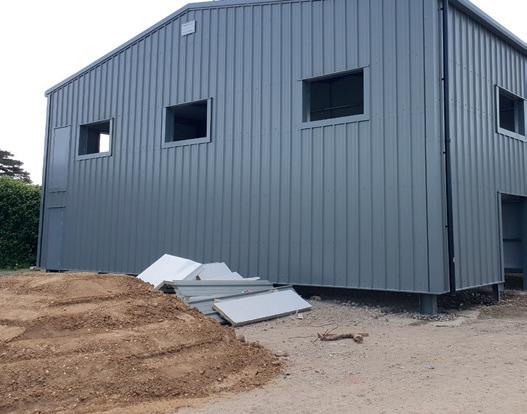



46 ANGLIA FARMER • MARCH 2024 Steel Framed Buildings Covering Bedfordshire, Cambridgeshire, Essex, Hertfordshire & Suffolk Looking for an independent, reliable and practical ‘one stop shop’ steel framed building service with the personal touch? Contact Johnstruct Ltd today... 01277 890 595 www.johnstruct.co.uk 4 FREE advice 4 Planning 4 Refurbishment 4 Project Management 4 Hassle Free
Non-farmers snap up half of all farmland sold last year
• Farmers account for fewest purchases
• Corporate investors snap up farmland
• Lifestyle buyers and big purchases
Non-farmers purchased more than half of all farms sold on the open market last year, suggest the latest figures from land agents Strutt & Parker.
Farmers accounted for the lowest level of transactions on record during 2023 – equivalent to only 44% of open market transactions during the year when historically they have tended to be involved in 50-60% of purchases.
Strutt & Parker said the figures confirmed the significance of private and institutional investors in the agricultural land market. This included overseas investors and corporations seeking to secure land for environmental reasons, including carbon sequestration.
Larger farms
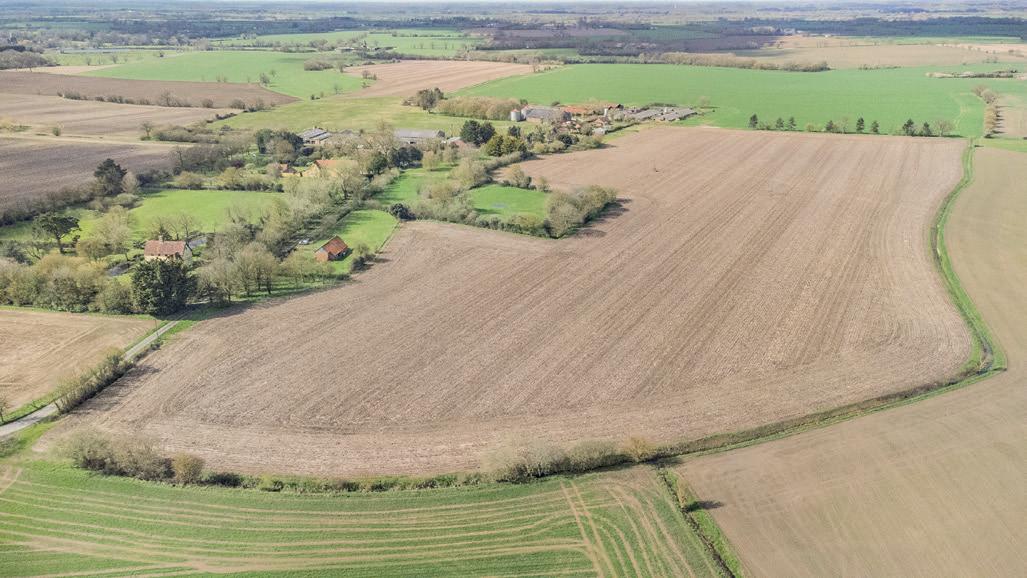
the marketplace this does not necessarily mean that the land in question is being taken out of food production.
“Many of the farms and estates continue to be productively farmed,” he said.
Non-farmer buyers – who include a mix of private and institutional investors and lifestyle buyers – accounted for 56% of sales. Because these purchasers also tend to buy larger farms, they bought a larger area of land than farmers too.
Private investors were involved in 28% of transactions, institutional investors in 13% – a rise of 10% on 2022 levels – and lifestyle buyers in 16%.
“The growing role of non-farmers has proved to be a defining feature of the farmland market in recent years,” says Matthew Sudlow, head of Strutt & Parker's farm agency. “What we have seen over the past 12 months is that farmers have understandably become more cautious.”
Factors included higher interest rates, falling support payments, cost pressures and the impact of some horrendous weather conditions. Meanwhile, investors and lifestyle buyers continued to see farmland as an attractive and safe long-term investment.”
Food production
While non-farmers are more active in
“Some of their new owners are placing more of a focus on regenerative farming techniques and improving biodiversity. Although there has been lots of media attention about land being bought for tree planting, the acreage involved in England at the moment is still tiny.
A 197-acre block of land in Suffolk, sold in September 2023 with a guide price of £2,000,000
Rising prices
This led to a slightly lower percentage of farms and estates selling at or above the guide price. That said, high prices have continued to be paid for bestin-class properties, pushing up average values, added Mr Sudlow.
The average price of arable land in England rose by 4% between 2022 and 2023, with an average price paid of £11,300/acre. Over 70% of the arable land traded in England during 2023 made more than £10,000/acre.





Context is everything when it comes to looking at trends, added Mr Sudlow. The total amount of land bought and sold each year typically represented less than 1% of the total agricultural land area, he explained.




As is usual, there was a much greater variability in pasture prices, because grassland can differ so much in terms of quality, with prices ranging from a low of £4,000/acre to a high of £16,100/acre, with an average of




“Even if the amount of land being bought by green investors is growing, it still represents a tiny percentage of the total land area. The reality is that most agricultural land continues to be in the hands of farmers despite what looks to be a significant shift in buyer types.”




The Farmland Database records the sale of all farms, estates and blocks of publicly marketed land in England over 100 acres in size. It shows overall that demand was slightly weaker in 2023 with interest becoming more variable in some regions.





£8,700/acre.


At 75,500 acres, supply on the open market fell slightly in 2023. But it was the second highest total in the past five years. Once off-market sales are factored in then it is estimated that well over 100,000 acres were available, which is the highest acreage for a number of years.






MARCH 2024 • ANGLIA FARMER 47 Professional services
Mathew Sudlow: must be seen in context
Thousands apply for Sustainable Farming Incentive
• More than 50 additional options
• 10% increase in payment rates
• Much easier application process
More than 10,000 farmers have now applied to join the Sustainable Farming Incentive (SFI) – and receive payments actions that support food production and the environment.
One-in-eight eligible farmers having submitted applications for the Defra scheme in the four months since it re-opened last September. This is on top of the 32,000 Countryside Stewardship agreements which are already in place.

tive has something on offer for every type of farm business, so it’s pleasing to see the scheme proving popular with farmers across England.
are under SFI management, says Defra
The SFI pays farmers for taking actions that support farm productivity and resilience while protecting and enhancing the environment. Defra said it had attracted applications from farmers across the country, with every type and size of farm business represented.
As of January, 174,000ha of arable land are now being managed without insecticides. A further 71,000ha of low input grassland are focused on improving sustainability, and almost 15,000km of hedgerows are under management.
It comes as Defra also announces the winners of the On-Farm Environ-
“For those who have not yet applied, I encourage you to take a look at how the scheme could work for your business so you can join the thousands of other farmers already getting paid.”
The relaunched scheme includes a simpler application process – developed by Defra following farmer feedback. There are 50 new management options for farmers to choose from and a 10% average increase in payments.
Help and advice
Farmers joining the scheme can be in Countryside Stewardship at the same time – so long as the actions they choose are compatible. Some 23 actions are already on offer with more to follow when the scheme ex-
“
It has something for everyone
Urging farmers to apply sooner rather than later, Defra said this would ensure growers could benefit from funding available now. They could then add actions to their agreements annually – or have multiple agreements – if they wanted to carry out further actions.
Sector-specific webinars will be held this March to give farmers and land managers a chance to give their feedback and learn more about SFI. Farmers can find out more about upcoming webinars and Defra regional events by visiting www.defra.gov.uk.
Defra representatives will be on stands at agricultural shows this summer with more information as it is announced. Farmers can also access free business advice through the Farming Resilience Fund, or by calling the Rural Payment Service helpline on 03000 200 301.
Key appointments for farming and environment team
Land agents and farm business advisers Bidwells has made two appointments to its agriculture and environment team.
In a senior consultancy role, Michael Muncey worked for Bayer in Europe before being appointed country manager for the company in the UK and Ireland. He will provide consultancy about enhancing farm and agricultural assets to landowners across the UK.
Matthew Page joined Bidwells as a graduate consultant after finishing a degree in agriculture at Harper Adams University. He will deliver farm management and consultancy
services, with a key interest in the sustainability of modern agriculture.
Ian Ashbridge, partner in Bidwells agriculture and environment team said: “Both Michael and Matthew’s appointments are really exciting as they will continue to strengthen the knowledge and skills within our team.
“The agricultural outlook is changing fast, as post-Brexit policy begins to be implemented and the transition away from area-based support payments takes effect. While prices for soft commodities have increased sharply, farm businesses are also seeing unprecedented cost pressure.”


48 ANGLIA FARMER • MARCH 2024 Professional services
Joining the team... Michael Muncey(left) and Matthew Page
Crop drying, ventilation and storage systems specialists.
Flach & Le-Roy Ltd is an industry leader in designing and delivering high performance drying, ventilation & storage systems.
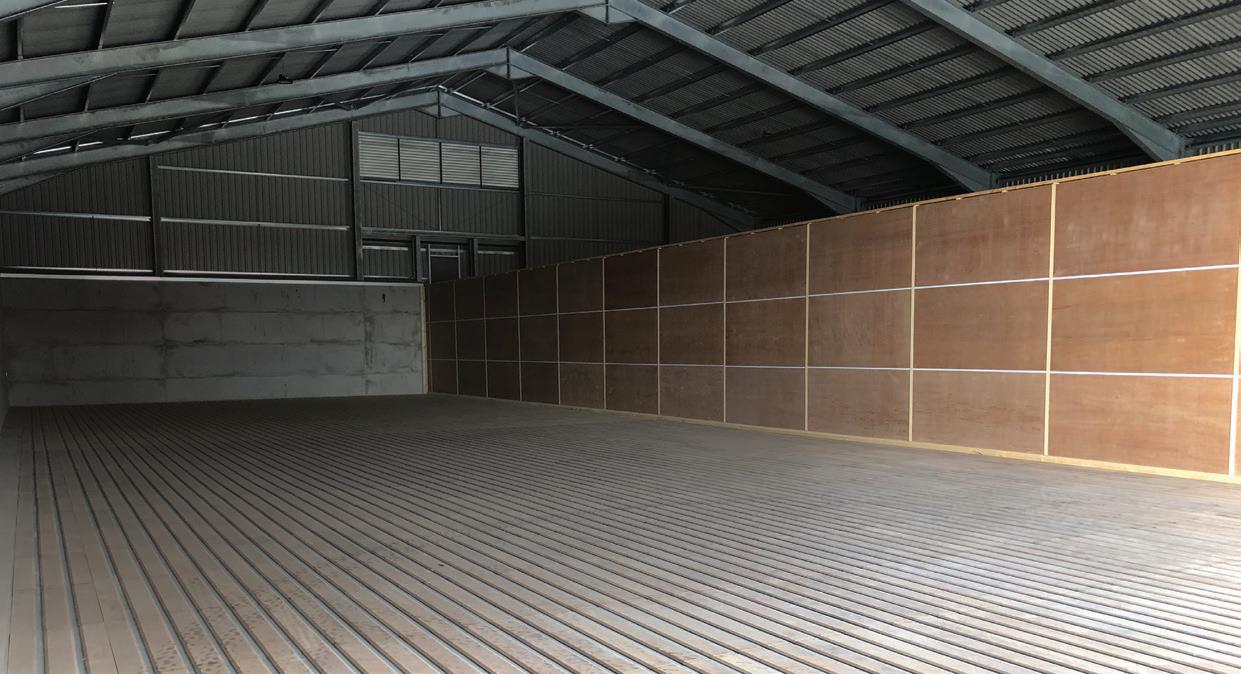
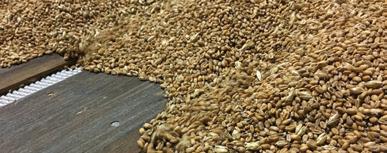





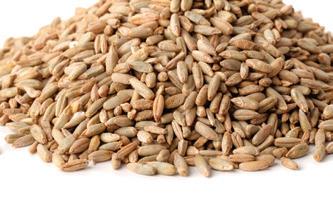





We have been supplying top quality drive-on and box store drying and storage installations to the arable farming industry globally for over 27 years and our business is continuing to grow.

“Drive
Drive-on Floor Systems • Letter Box Duct Systems • Control Systems
Centrifugal & Axial-Flow Fans • Gas Burners • Walling Systems



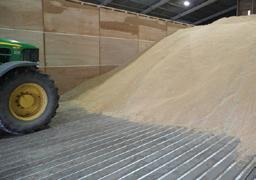
Telephone: 01480 495956
Mobile: 07774 141512
Email: enquiries@flruk.com
Website: www.flr-cropdrying.com
Guarantee Manufactured in England
& Le-Roy Ltd
10 year
Flach
experience in
industry
35 years
the
systems
on Dry off ”

Tyre Specialists Agricultural



24 HOUR CALL OUT:

0800 99 99 247













Equipment - Livestock - Feed - Fertiliser - Seed - Cash Flow Diversification Projects - Building - Debt Consolidation
Equipment - Livestock - Feed - Fertiliser - Seed - Cash Flow Diversification Projects - Building - Debt Consolidation
Equipment - Livestock - Feed - Fertiliser - Seed - Cash Flow Diversification Projects - Building - Debt Consolidation

• Finance from £10k to £5m
• Excellent rates
• 6-month to 20-year terms
• Tax efficient
• Simple, quick phone application
• Decision within 24-hours
• Bad credit history, large debts... No problem!
• High street banks unsupportive
• Tenant farmers welcome
We bring the personal touch back into farm finance. For the personal touch, ring George Bridgman on 07522 731193 george.bridgman@abfltd.co.uk
w w w . t r e a d f i r s t . c o . u k
A t y o u r f a r m , y o u r f i e l d , o r r o a d s i d e 50 ANGLIA FARMER • MARCH 2024 Only available in England, Wales & Scotland
Professional services
New rights could make diversification easier


Changes to permitted development rights could benefit farmers, says Suzanne Tucker
Farmers and landowners could find it easier to convert old buildings into new homes following changes to permitted development rights.
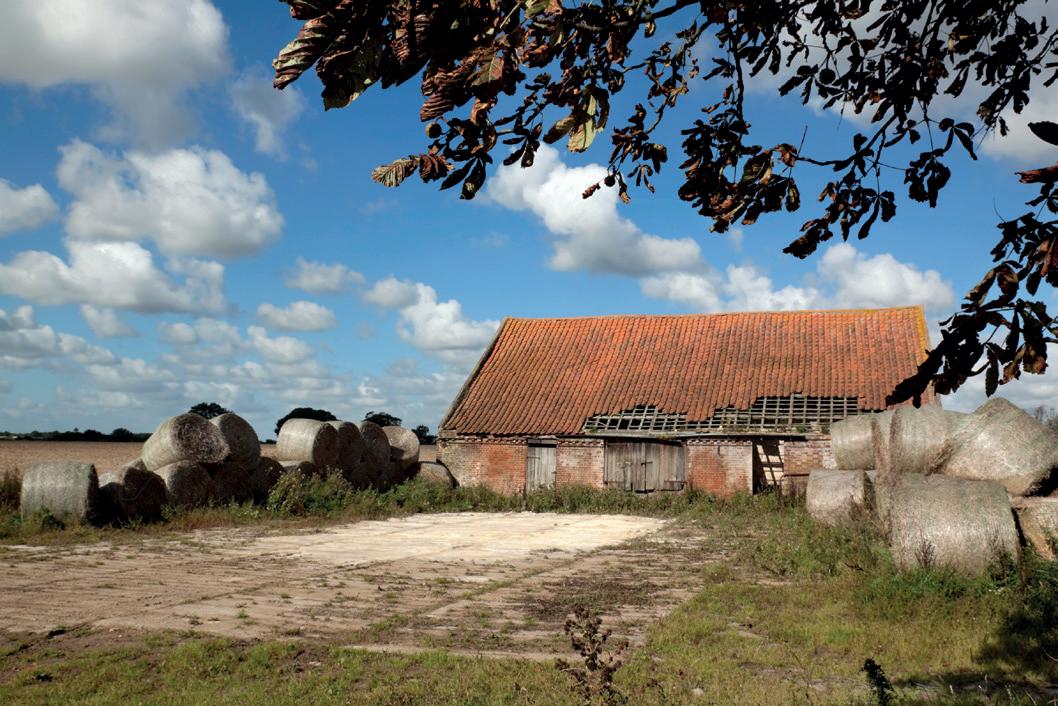
The UK is facing a national shortage of good quality and affordable homes, so a raft of new measures have been suggested to stop unnecessary planning red tape slowing down the delivery of new properties.
One of the ways the Government is proposing to make the planning system more efficient and effective to overcome the shortfall in housing supply is by amending permitted development (PD) rights.
Some of these proposed changes apply to agricultural permitted development and, if made law, new legislation will soon allow farmers to diversify the use of buildings and deliver new housing on their land without the need for a long and arduous planning process.
More conversions
The first planned changes are to the size and number of Class Q homes – agricultural buildings converted into dwellings – which can be delivered by a farmer.
This will allow more homes to be delivered, and expand the type and location of buildings that can benefit from the right as well as extending the scope of works that can be undertaken.
Government proposals are to simplify regulations to a single maximum floorspace of 100 or 150m2 per home, while the maximum number of homes increasing from five to 10 per agricultural unit with an overall maximum floorspace changing use of 1000sqm.
This encourages farmers to deliver a greater number of smaller homes on their land, by re-using existing buildings and thereby reducing the pressure to build homes on greenfield sites, says Ms Tucker.
“It's worth noting that whatever building you would like to convert into a dwelling must be suitable for conversion. Full demolition and rebuild is not allowed.
“Permitted works for a barn conversion include things like the installation or replacement of windows and doors or adding water, drainage, gas and electricity supplies."
Rear extension changes
The proposed changes suggest that rear extensions to Class Q conversions be allowed. Previously, any increase in the size of the original agricultural building was not allowed but this could be waived in the future.
This could allow single storey extensions of up to 4m to the back of a building if the land is already hard-surfaced (for example if it’s a farmyard), with any extension falling within the overall floorspace limit.
Whatever dwellings farmers have planned, the existing agricultural building must comply with minimum space standards (a floorspace of 37sqm) before being granted permission to be developed.
The proposed new Class Q PD rights could be extended to apply to National Parks and Areas of Outstanding Natural Beauty with a view to delivering more rural homes in such locations through the re-use of underused buildings.
The proposed allowance for rear extensions would not apply in these locations and World Heritage Sites are not included within the areas benefitting from this proposed expansion of the PD rights.
Changes to permitted development rights
A potential conversion must be suitable
seek to bring back into use agricultural buildings which are no longer part of an established unit.
Under the proposed changes, planning for a change of use could be granted permission, for example, for a barn which was once part of a working farm, but is no longer part of the main agricultural unit.
There are also proposed changes to the PD rights allowing changes of use of buildings from agricultural to commercial use (Class R). This includes extending the legislation to buildings currently used for forestry or equestrian use.
It would allow different uses, such as outdoor sports or fitness or the processing of raw goods which have been produced on the farm and will be sold on site. It could also allow a mix of uses and a doubling of the allowable floorspace to 1,000sqm.
Extending your business
You may want to extend or build more properties on your farm for your own agricultural use, and under the proposed changes, there could be greater flexibility to do this.
Class A of Part 6 – which permits the building or extension of agricultural buildings and excavation and engineering works on units of 5ha or more – could be amended to increase the size limit by 500 square metres.
This would allow for any new building or extension erected to include other such development within the last two years to cover up to 1,500m2 of ground area.
Class B of Part 6 (relating to smaller units of less than 5ha) could also be amended to raise the ground area limit within the rolling two year period to 1,250m2, up from 1,000m2.
Suzanne Tucker is a partner at Shropshire law firm FBC Manby Bowdler
MARCH 2024 • ANGLIA FARMER 51
“

Biodiversity Net Gain is 'opportunity for farmers'
ew rules requiring developers to replace wildlife habitats destroyed during construction projects could provide an opportunity for farmers.
After years of proposals, the Biodiversity Net Gain (BNG) policy came into effect on 12 February. It means developments of 10 or more dwellings must deliver at least 10% improvement in wildlife habitat than there was before the development took place.
David Hill, who pioneered the concept of BNG, said he welcomed the implementation of the BNG framework.Professor Hill is past president of the Chartered Institute of Ecology and Environmental Management and chaiman of the Environment Bank.
“From now on, almost all development will be required to comply with BNG. This much-needed and transformative legislation will deliver vital investment to the natural environment, restoring ecosystems and building resilience against the effects of climate change.
“It was in 2004 that I first suggested that all development should be required to create gains for nature as a result of the development activity. I have promoted the concept of BNG for nearly 20 years, establishing Environment Bank to obtain land to put into nature.”
Describing the implementation of BNG as a game-changer, Prof Hill said it could be a big benefit for farmers. “With farming families facing innumerable challenges, the mandating of BNG means a diversified income stream for farmers.”
The model favoured by Environment Bank involves leasing land to preserve and restore natural ecosystems. Farmers and landowners retain ownership and management of the land, receiving tax-efficient annual payments of up to £60,000 per year, secured for 30 years.
The Biodiversity Units from these Habitat Banks are then raised for developers, with Environment Bank taking all liability for their delivery. This helps developers meet their BNG requirements – now mandated in law from this month – while supporting nature restoration at scale.




52 ANGLIA FARMER • MARCH 2024
FARMING NEWS –WHEREVER YOU ARE! EASY WAYS TO STAY IN TOUCH WITH ALL THE LATEST FARMING NEWS FROM AROUND THE REGION 3 Visit angliafarmer.co.uk Sign up to our weekly newsletter Follow us on social media
David Hill: pioneered concept of Biodiversity Net Gain






















TANKS INDUSTRIAL STORAGE TANKS HIRE - NEW - USED 01502 710100 info@regaltanks.co.uk EAR PROTECTION COMMAND PEST CONTROL LTD • GRAIN MONITORING • GRAIN STORE TREATMENTS TEL: 01787 248049 Local staff in all regions covered by Anglia Farmer www.commandpestcontrol.co.uk Command House, Church Lane, Preston St Mary, Suffolk CO10 9NQ • RODENT CONTROL • GRAIN FUMIGATION AF DIRECTORY PEST CONTROL Custom Moulded Ear Defenders Ultra comfortable, re-usable & last for years. Acoustic filter allows you to still hear everything, whilst protecting you from harmful noise levels. Available with CE approval. Earpieces are custom moulded from soft silicone, and offer the highest degree of comfort whilst providing an effective acoustic barrier. Choice of colours available. Ideal for shooting - maximum protection without imparing hearing. Autotel Ltd - 01508 528837 • www.autotelradio.co.uk Crow Tree Farm, Crow Tree Bank, Thorne Levels, Doncaster, South Yorkshire, DN8 5TF info@webstersinsulation.com www.webstersinsulation.com FOR A FREE QUOTE CALL: 01405 812682 Sprayed Foam Insulation Specialists INSULATION Sandy Lane Nursery Wattisfield, Diss, Norfolk Native and ornamental trees, hedging and shrubs Tel: 01359 251678 sales@sandylanenursery.co.uk www.sandylanenursery.co.uk NURSERY LANDSCAPING & MAINTENANCE TO ADVERTISE IN THE ANGLIA FARMER BUSINESS DIRECTORY CALL 01502 725144 Grademore Ltd Suppliers of Reclaimed Telegraph Poles, New & Reclaimed Railway Sleepers, Concrete Railway Sleepers, Motorway Crash Barriers. 01760 724237 www.grademore.com enquiries@grademore.com MATERIALS & MACHINERY T.G. ASKEW T.G. ASKEW BLUE PUMP FARM, LOW ROAD, BRESSINGHAM, DISS, NORFOLK IP22 2AA Bulk haulage • Aggregate Road Planings • Stock Feed For further information please contact T: 01379 388156 F: 01379 388109 Email: jeremy@tgaskew.co.uk 01638 712328 tanks@thekinggroup.co.uk STORAGE TANKS KING Tel 01638 712328 www.thekinggroup.co.uk/tanks Horizontal Cylindrical Tanks From 54,500 litres to 27,250 litres (12,000 - 6,000 Single and twin compartments, with cradles Bunded Tanks
27,000 litres to 10,000 litres (6,000 - 2,000 gallon) With cabinet, guage and alarm All suitable for fuel, water and effluent Call today for details STORAGE TANKS KING Tel 01638 712328 www.thekinggroup.co.uk/tanks Horizontal Cylindrical Tanks From 54,500 litres to 27,250 litres (12,000 - 6,000 Single and twin compartments, with cradles Bunded Tanks
27,000 litres to 10,000 litres (6,000 - 2,000 gallon) With cabinet, guage and alarm All suitable for fuel, water and effluent Call today for details STORAGE TANKS KING Don’t run short of fuel this Winter! Buy or hire a storage tank from Kings 4500L – 38,600L Bunded Fuel Tanks c/w cabinet, gauge and alarm
– 54,500L horiz/cyl Water Tanks single or twin comp. with cradles lifttechinspection.com An Alternative to Insurance Inspections 07873 547276 info@lifttechinspection.com LOLER Testing Of All Lifting Plant PSSR Pressure Vessel Testing Get Compliant. Save Money
From
From
2730L

FINAL SAY Fen Tiger
Vive la France!
French-style protests are needed for British farmers to get a better deal, says Fen Tiger
Rebellion. It's happening across Europe. Farmers are protesting against low prices, unachievable carbon targets, unfair foreign competition and rising costs.
You have to chuckle silently when French farmers complain of an uneven playing field and dwindling farm support payments. How many years have they ignored all the rules despite being the biggest beneficiary of money from Brussels? They seem to be a law unto themselves.
But the French get results. What do us British farmers do? We moan and groan and accept our fate. Our union says protest should be the last resort – doing nothing to support our stance. Rather than laugh, we should applaud our fellow French farmers and their union leaders.
Thousands of French farmers block major roads and the majority of the French popu-
“
Our incomes are shrinking

lation continue to value and support them. Here, farmers in Wales hold a demonstration at Carmarthen livestock market and so few people notice they could almost be invisible
The French union is so powerful that French prime minister Gabriel Attal feels moved to defend the farming sector calling it “our strength, our pride”. Mr Attal has already met with French farm leaders and given in to their demands.
He has paused on the new pesticide ban, reversed a price hike on tractor diesel and pledged to go no further than EU law requires when it comes to environmental restrictions. A long list of promises or grand words to placate the French farmers?
Green envy
Environmentalists are concerned. They question France's commitment to planet-friendly policies in the face of such protests. But French farmers can no longer earn a living due to cheap imports, reduced subsidies and a rise in production. Welcome to the real world!
French farmers face similar problems as farmers here in Britain. Our incomes are shrinking. Most of our farms are classed as either arable, livestock or mixed. But the French include vineyards and cheese-makers – farming is a fundamental part of their national cultural heritage.
Unlike our own NFU, the French have smaller unions but more of them. These un-
ions vary in their ambition and commitment to the cause. Taken together, though, the power of French farmers and the power of their agricultural sector should not be underestimated.
Radical change
Smaller local protests have been held here. And it's great pity that our own union lacks the power or steel to organise any similar French-style action. Weak and unable to influence government policy, its time for a radial change in our agricultural sector.
At the very least, the NFU should be taking out advertisements in local newspapers highlighting the gulf between retail food prices and farmgate returns. But in reality, much more is needed to fight farming's corner – much, much more.
With a keen focus on reducing greenhouse gas emissions, government policies are slowly killing our farms. Making a living from food production is difficult enough without needless meddling by politicians who see farming as part of the problem rather than a potential solution.


So we plod on accepting what is pushed upon us – and wait for the real possibility that is a change of government. It's not an ideal situation but it is one that has remained unchanged for decades. And it will stay that way unless our unions start to make real political progress.



54 ANGLIA FARMER • MARCH 2024 Olga Besnard / Shutterstock.com




For farmers looking to plant trees, we offer a unique partnership to design, plant and manage the trees and sell the carbon units for you.
Simon a call on 07825 193278 or email: enquiries@tilhill.com tilhill.com
Give





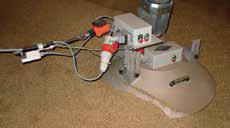





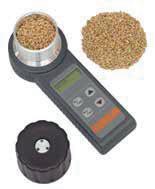


Marrison Agriculture Limited, 1 Ironside Way, Hingham, Norfolk, NR9 4LF. www.marrisonagriculture.co.uk 01953 851 771 Moisture Meter Clinic 2024 Sinar 6096 Sinar 6070 Sinar 6300 Sinar 6095 Protimeter Grainmaster Straw Bale Moisture Meter Grain Stirrers Aeration Pedestals and Fans Marrison Agriculture are holding our annual moisture meter clinic in Hingham on Wednesday 8th and Thursday 9th May 2024. Please call to make an appointment. Call now for special offers on moisture meters, aeration pedestals and post-harvest storage equipment. Marrison Agriculture Limited, Unit 8 Ironside Way, Hingham, Norfolk, NR9 4LF




















































































































































































































































































































































































































































































































































































































































































































